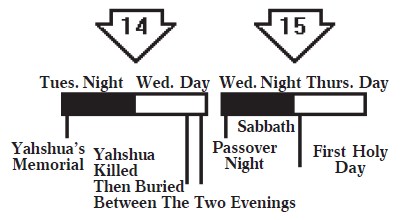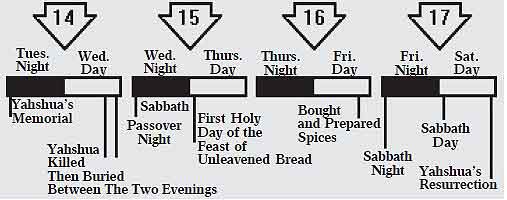|
My Dear Friends,
Even the act of sodomy is called “holy” by the preachers who practice pedophilia. This was done by the Hebrew religions that called themselves Pharisees, Sadducees, and Essenes before they moved to Rome and accepted the name Catholic, which means universal. Satan, when she deceived Eve, as seen in the Book of Genesis, made Satan worship appear the same as it’s made to appear in Hollywood today. It’s being accepted today even as it was in the beginning. Notice: .Revelation 12:9— And the great dragon was cast out, that old serpent, called the devil, and Satan, who deceives the whole world. She was cast out into the earth, and her angels were cast out with her. .Genesis 3:6— So when the woman saw that the tree was desirable for food, that itwas pleasant to the eyes, and a tree desirable to make one wise, she took of its fruit and ate. She also gave to her husband with her, and he ate. .II Corinthians 11:13-15— 13 For such are false apostles, deceitful workers, transforming themselves into the apostles of the Messiah. 14 And no marvel; for Satan herself is transformed into an angel of light. 15 Therefore, it is no great thing if her ministers also aretransformed as the ministers of Righteousness—whose end will be according to their works. But they did not fool Yahshua. Notice what He says. .Mattithyah 7:13-23— 13 Enter in through the narrow gate; for wide is the gate and broad isthe way that leads to destruction, and many are those who go that way. 14 Because straight is the gate, and narrow is the way which leads to Life, and few there are who find it. 15 Beware of false prophets who come to you in sheep’s clothing, but inwardly they are ravening wolves. 16 You will know them by their fruits. Do men gather grapes from thorns, or figs from thistles? 17 Likewise, every Righteous tree brings forth Righteous fruit; but atree of evil brings forth fruit of iniquity. 18 A Righteous tree cannot bring forth fruit of iniquity, nor can a tree of evil bring forth fruits of Righteousness. 19 Every tree which does not bring forth Righteous fruit is cut down, and cast into the fire. 20 Therefore, by their fruits you will know them. 21 Not everyone who says to Me; Teacher! Teacher! will enter into the Kingdom of Yahweh, but only he who does the Will of My Father Who is in heaven. 22 Many will say to Me in that day; Teacher! Teacher! Have we not prophesied in Your Name, and cast out demons in Your Name, and in Your Name performed many wonderful works? 23 But then I will declare to them; I never knew you. Get away from Me, you who practice iniquity. Most people think nothing of celebrating Easter because it’s celebrated by people all over the world. The most they ever hear about this form of worship is the lies that are taught to the children about rabbits laying colored eggs on Easter Sunday. Sometimes but rarely are they ever told that their bible shows that this worship is of the Queen of Heaven and not the Creator Yahweh or the Savior Yahshua. Nor are they told that the Queen of Heaven is well described in Scripture as being worse than a whore, and that the rabbit was chosen as an unclean object of sexual perversion. People today are taught not to read their bibles. In fact, up until a few years ago it was illegal to own, read, teach or practice what the Creator Yahweh inspired the Prophets to write in what is called the bible today. The crusades conducted by the popes (yes, the Catholic church) were fought against the Savior’s followers who owned, read, taught and practiced the worship of Yahweh written by the Holy Prophets. History shows that the believers of Yahshua, the One called the Savior (yes, His Name is Yahshua) and His followers, starting with the twelve Disciples and their followers, were hunted down and murdered for following the written instruction found in your bible. Some preachers know the evil in this worship but they try to convince people that the Savior was raised from the dead on Sunday morning so that’s why they worship the Easter Goddess on Easter Sunday. However, the Savior did not rise on Sunday morning. The article within this magazine about Easter proves from your bible that the Savior was put in the grave on Wednesday and rose three days and three nights later on Saturday evening. So if they truly wanted to celebrate the resurrection of the Savior, they would celebrate the Seventh Day Sabbath as commanded. .Mattithyah 19:17— But He said to him: Why do you question Me about Righteousness? There is only One Who is the Standard of Perfection, and He is Yahweh; so if you would enter into Life, keep the Laws of Yahweh. .Revelation 22:12-14— 12 And behold, I come quickly, and My Reward is with Me, to give every man according as his work will be. 13 I am the First and the Last, the Beginning and the End. 14 Blessed are those who keep His Laws, that they may have right to the Tree of Life, and may enter in through the Gates into the City. .Exodus 20:8-11— 8 Remember the Sabbath Day, to keep it Holy. 9 Six days you shall labor and do all your work, 10 But the Seventh Day is the Sabbath of Yahweh your Heavenly Father. In it you shall not do your work: you, nor your wife, nor your son, nor your daughter, nor your manservant, nor your maidservant, nor your cattle, nor the stranger whodwells within your gates. 11 For in six days Yahweh made the heavens and the earth, the sea, and all that are in them; and rested the Seventh Day. Therefore, Yahweh blessed the Sabbath Day, and hallowed it; Yahweh made the Sabbath Day Holy. Worshiping the Easter Goddess is not a commandment. Worshipping on Sunday is not a commandment. If you would enter into Life as the Savior said, you must keep the Commandments (Laws). .Mattithyah 19:17— But He said to him: Why do you question Me about Righteousness? There is only One Who is the Standard of Perfection, and He is Yahweh; so if you would enter into Life, keep the Laws of Yahweh. .Revelation 22:14— Blessed are those who keep His Laws, that they may have right to the Tree of Life, and may enter in through the Gates into the City.
.I Yahchanan 2:4— He who says: I know Him, but does not keep His Laws, is a liar, and the Truth is not in him. .Romans 6:16— Do you not know that to whom you yield yourselves as servants to obey, his servants you are whom you obey—whether of sin, which leads to death, or of obedience, which leads to Righteousness? .I Yahchanan 3:4, 7-8— 4 Whoever commits sin, transgresses also the Laws; for sin is the transgression of the Laws. 7 Little children, let no man deceive you; he who practices Righteousness is Righteous, just as He is Righteous. 8 He who commits sin is of the devil, for the devil has sinned from the beginning. For this purpose the Son of Yahweh was manifested; that He might destroy the works of the devil. I urge you to closely study, with your bible, the following articles that expose the Satan worship that has deceived the whole world. Recommended reading: The Lost Faith of the Apostles, History and Prophecy and Devil Worship, The Shocking Facts. May Yahweh bless your understanding. Love, True Love In Yahshua Messiah Yisrayl Hawkins |
Was The Messiah’s Birth On December 25th?
Authoritative educational books of the world, such as encyclopedias, give us the truth. In our own Holy Scriptures, long before the virgin birth, the Creator speaks of this festival being celebrated, as Yeremyah 10:1-5 indicates.
.Yeremyah 10:1-5—

2 This is what Yahweh says: Do not learn the way; religious practices, of the heathen; Gentile nations; and do not be deceived by the signs of heaven; though the heathen are deceived by them; using them to set their feasts.
3 For the religious customs of the peoples are vain; worthless! For one cuts a tree out of the forest, the work of the hands of the workman, with the ax.
4 They decorate it with silver and with gold; they fasten it with nails and with hammers, so that it will not move; topple over.
5 They are upright, like a palm tree, but they cannot speak; they must be carried, because they cannot go by themselves. Do not give them reverence! They cannot do evil, nor is it in them to do Righteousness!
.The Encyclopedia Britannica, Volume II (1943-1973), under Christmas, says:
“`In the Roman world, the Saturnalia was a time of merrymaking and exchanging of gifts. December 25th was also regarded as the birthdate of the Iranian Mystery god, Mithra, the Sun of Righteousness.
On the Roman New Year houses were decorated with greenery and lights and gifts were given to children.
To these observances were added the German and Celtic Yule rites…Food and good fellowship, the Yule log and Yule cakes, greenery and fir trees, gifts and greetings all commemorated different aspects of this festive season. Fires and lights, symbols of warmth and lasting life have always been associated with the winter festival, both pagan and Christian.”
In A Book of Christmas, by William Sansom, McGraw-Hill, 1968, pages 28-39, we find the following information:
To get green food for his beasts and later for himself when the first corn was planted, primitive man neededrain and sun. So, with their primitive eyes on the great and mysterious sky…the first religious instincts prayed to the sun! The moment of the Sun’s Annual rebirth in late December was one of the vital religious times of the year. This time of year was also the least laborious. There was time to make merry. Early Northern people, who had no exact astronomical findings began their winter festivals earlier…in November… when the signs of the sun’s recession… (dying) and the scarcity of animal food made the slaughter of the increase of the herd necessary. Later, the ceremonies moved forward to mid-December and the anticipation of the Saturnalia…that wonderful, heartwarming, emotional festival introduced by the Romans by their occupation of the then-known world.
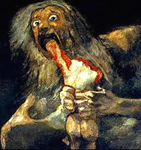
The giving of presents…particularly candles and dolls called Sigillaria also derives from the insistent origin of human sacrifice at this time of year!
Directly following the Saturnalia was the Kalendae…more mathematically concerned with the date of the new Roman year…and the celebration of the god Janus, god of doors (as a two-way engine) who looks back on the past and forward to the future.
One may think of the Saturnalia as `Roman in Rome‘…but the truth is: The Roman Empire was a World-Ruling Empire at that time. The customs of Rome were spread to all the known world! Britons and Celts, Indians and Egyptians were all called part of the Roman Empire at one time. These nations brought their ownSun Worshipping Cults to join into the Saturnalia Celebrations! It was an Empire-Wide Celebration. All the people in this Empire, save only a few…gathered in their homes to drink wine…to dance and sing…to light their candles and exchange presents…giving their children the little clay dolls that represented their former sacrifices!
The Strenae…honoring the goddess Strenia…were given for `good luck!’
The Feast of Fools and the Lord of Misrule derived directly from the Saturnalia.
Many other customs have become engrafted into the ancient celebration occurring at this time of year. Mummers and Wild Men roam the British Isles and Europe. The Mari Lwyd ritual in Wales is reviving. Theevergreen tree is an ancient custom incorporated. The Vikings gave their Yule…the druids donated their magic mistletoe…the Father Christmas in Briton and the Santa Claus of German origin were all donated and incorporated into the holidays known worldwide as Christmas and New Year!
It was not until the middle of the fourth century c.e. that the `Birth’ of the Messiah was officially celebrated at the time of year when the lighting of fires…the praising of the new sun…relaxation and feasting was set on the very same date as that of the birth of the sun god…Mithra!
MITHRAISM: The worship of Mithra shared many similarities with the newer Christian ceremonies. There was baptism, a sacramental meal, and observance of Sunday, and the god himself was born on December 25th.
The Ancient Pagan Celebrations Of Modern Christmas And New Year
In Revelation 1:1, the Apostle Yahchanan is given the revelation of what will shortly come to pass at the end of this age. Yahchanan is shown the history of The House of Yahweh and the end of the Babylonian mystery religions that this whole deceived world worships in this very day and time.
.Revelation 17:1—
And there came one of the seven malakim who had the seven bowls, and talked with me, saying to me: Come, I will show you the sentence of the great whore that sits upon many waters.
The word waters in this verse is referring to peoples, and multitudes, and nations, and tongues, as we find in:
.Revelation 17:2-6—
2 With whom the kings of the earth have committed fornication; practiced idolatry: Godworship (the worship of elohim),and the inhabitants of the earth have been made drunk with the wine of her fornication.
3 So he carried me away in the Spirit into the midst of Godworshipers (worshipers of Elohim); and I saw a woman sitting on a scarlet colored beast, full of names of blasphemy, having seven heads and ten horns.
4 And the woman was arrayed in purple and scarlet color, and decked with gold, and precious stones, and pearls, having a golden cup in her hand full of abominations and filthiness of her fornication.
5 And upon her head was a name written: Mystery Babylon the great, the mother of the harlots and of the abominations of the earth.
6 And I saw the woman drunk with the blood of the saints, and with the blood of the martyrs of Yahshua. And when I saw her, I wondered with great astonishment.
.Revelation 17:15—
And he said to me: The waters which you saw, where the whore sits, are peoples, and multitudes, and nations, andlanguages.
In Revelation 17:5, we are shown a religion of mystery, the great whore, or great God worshiper, as this religion should be called, which brings abominations to all peoples, multi-tudes, nations and languages.
Collier’s Encyclopedia, 1980, Volume 16, pages 349-350, tells us of these ancient mystery religions.
THE MYSTERY RELIGIONS
The mystery religions furnish an ancient example of a missionary movement. Originally they were magical ceremonies designed to induce bountiful crops. They dramatized the annual decay of vegetation in the autumn as the death of a divine youth over whom a goddess mourned. Later they celebrated with ecstatic joy the return of verdure in the spring as the coming to life again of the departed youth. Participating in these rites was believed to cleanse the devotee of his sins and unite him mystically with the god. They were crude and orgiastic but they had a dynamic quality which led to their expansion.
In spite of the protests of such men as Euripides and Plato the mystery religions continued to make convertsbecause they supplied something which neither the religion of the Olympic gods nor the philosophers of Greece could offer. This was especially true of the Eleusinian mysteries which may have had their origin in Egypt.
Though the details of these rites are unknown, because they were secret, it is evident that the drama which the initiates saw enacted was a source of great comfort to them thereafter, attracting at Athens alone thousands of candidates who thronged to be initiated.
The Syrian mystery religion in which the goddess Astarte wept over Adonis was carried by Phoenician sailors and traders to various ports in the Mediterranean at an early date. Later, when this sea was controlled by the Ptolemies, Egyptian sailors and traders carried the mystery religion of Isis to Cyprus, Sicily, Italy, Gaul, and Spain. This religion, transformed considerably from its Egyptian prototype, had great popularity in Rome, and held its own for 500 years. It was at one time a formidable rival of Christianity.
Mithraism, which was also a rival of Christianity in the early centuries, seems to have had many affinities with the mystery religions, especially in its graded series of seven stages of initiation. Mithra or Mithras was the name of an ancient deity among the Aryans. Originally he was the god of the social order, but in Persian religion he had warlike characteristics, being a manifestation of the power of the sun, fighting against darkness on behalf of Ahura Mazda. His emblem was sol invictus, the invincible sun, and his help was sought especially by those engaged in warfare.
The Romans became acquainted with Mithraism in 66 B.C. Pompey had been given dictatorial powers to suppress the pirates who swarmed the Mediterranean. He captured their strongholds in Cilicia at the eastern end of the Mediterranean, took 20,000 prisoners and settled them at various points in Asia Minor and Greece. These captured Cilician pirates introduced Mithraism to the Romans. It did not make much headway, however,
Has Mithraism, Or Sun Worship, Really Come To An End
In These Modern Times?
In the earliest millennium, the great mother goddess was a symbol of procreation and fertility and was worshiped in every corner of the world. This mother goddess was pictured as the sun and earth and her consort as the moon and the natural elements.
The Babylonians, in their popular religion, worshiped a goddess mother and a son, represented in pictures and images as a mother with her son in her arms. From Babylon this worship of the mother and her child spread to the ends of the earth.
The original Babylonian mother goddess was Semiramis. The adored little child in her arms was Ninus (Tammuz), signified as the son. This same little child was also signified as the husband of Semiramis.
The Madonna and child worship certainly did not start in the Christian era.
We are told of the first government system by the people and of the people, and against Yahweh in:
.Genesis 10:8-9—
8 Cush begot Nimrod; he began to be a mighty one on the earth.
9 He was a tyrant who deceived, who turned against Yahweh; therefore it is said: Like Nimrod the tyrant who deceived, who turned against Yahweh.
It has been said that the custom of Christmas “started with Semiramis and the birth of her illegitimate son, Tammuz.
Legend has it that Tammuz was so evil he married his own mother, Semiramis. After Tammuz’s untimely death, his mother/wife brought forward the doctrine of the resurrection of Tammuz. She claimed a full grown evergreen tree sprang up overnight from a dead tree stump. She also claimed that Tammuz would visit the evergreen tree on each anniversary of his birth and leave gifts upon it.
Semiramis, through her scheming, became the Babylonian Queen of Heaven. She introduced a worship to usher in the rebirth of her son every year.
.Yeremyah 7:18—
How the children gather wood, and the fathers kindle the fire, while the women knead dough to make cakes for the Queen of Heaven, and how they pour out drink offerings to the hinder gods (elohim), so they may act defiantly against Me?
.Yechetzqyah 8:14—
Then he brought me to the door of the gate of Yahweh’s House, which was toward the north; and behold, there sat women weeping for Tammuz.
In this ancient act of sun worship, women would ceremonially weep until Tammuz was reincarnated as the evergreen tree. Tammuz’s birthday was December 25th.
The festival of Mithras, the sun God of ancient Persia, was celebrated on December 25th. Tree worship and celebrating a birthday on December 25th certainly did not start in the Christian Era.
The Last Two Million Years, by The Readers Digest Association, 1971, page 77, says:
Worship of the sun-god
For the next 500 years Persia came under the rule of the Parthians, a warlike people from the north-east. This was a period of almost ceaseless conflict with Rome, from which neither side emerged victor. Roman soldiers carried back to Europe the Persian worship of Mithras, the sun-god. If Mithraism had not been superseded in the Roman Empire by Christianity, Europe might have adopted the Persian religion.
.Collier’s Encyclopedia, 1980, Volume 9, page 431, says:
Roman Religion and the Emergence of Christianity.
The religion of the Romans also displayed lack of imagination. As encouraged by Augustus and some of his successors, it was a cold, remote affair of ceremonies and rituals. Much had been borrowed from the Greeks, but, as so often occurred, the Romans took the shell and left the kernel; the charm of the old Greek religion was lost. As social and economic conditions became worse, the Roman masses turned more and more to the colorful, strongly emotional, and superstitious mystery religions imported from the East. The cults of theGreat Mother, of Isis, and of Mithras were the most popular. They all emphasized spiritual salvation and a future life__in a word they offered comfort. The cult of Mithras, which appealed primarily to men, became very strong and was carried throughout the Empire by the constantly moving Roman legions. It was to be the chief rival of Christianity.
Was Mithraism the chief rival of Christianity or is Christianity just the name of Mithraism in this day and age? Constantine was still a sun worshiper when the religion that is called Christianity today was initiated.
Collier’s Encyclopedia, 1980, Volume 21, page 632, says:
SUNDAY. To understand the meaning and significance of Sunday as the first day of the week it is necessary to consider the five contributions which have been made to its place in the calendar and to its manner of observance: (1) the worship of the sun among ancient peoples, (2) the popularity of Mithraism among the Romans, (3) the Roman observance of the day of the Sun, (4) the early Christian dedication of the first day of the week as a memorial of the resurrection of Christ, and (5) the Scottish Presbyterian conception of Sunday as a day of rest and the adoption of this conception by Puritan Massachusetts, with the resulting Sunday laws, usually known as Blue Laws.
From prehistoric times to the close of the fifth century of the Christian Era the worship of the sun was dominant. Deified in Egypt as Ra, the Sun-god, he is pictured in the oldest passages of the Pyramid texts. The sun-disk (Aton) with the outspread wings of the falcon became the most generally used symbol of Egyptian religion. In Babylonia, cylinder seals picture the sun as a deity coming forth through open doors which attendants hold open for him, at the same time turning their faces away so as not to be blinded by his brightness. This idea of the sun having a habitation is reflected in the Biblical reference to his coming forth as a bridegroom from his chamber rejoicing as a strong man to run his course. When the Israelites entered Palestine they found the worship of the sun under the name of Baal-hammon, the latter part of this titlemeaning sun images.
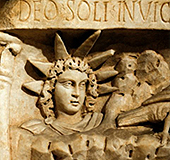
The early Christians had first adopted the Jewish seven day week with its numbered weekdays, but by the close of the third century the planetary week, and in the fourth and fifth centuries the pagan calendar names had become general in western Christendom.
This says: “`The earliest known Sunday law appeared in the Edict of Constantine in 321 C.E. enacting that magistrates, city people and artisans were to rest on the veneral day of the sun.” This is not the only enactment that resembles present day Christianity.
The Last Two Million Years, by The Readers Digest Association, 1971, pages 217-218, says:
By a stroke of tactical genius the Church, while intolerant of pagan beliefs, was able to harness the powerful emotions generated by pagan worship. Often, churches were sited where temples had stood before, andmany heathen festivals were added to the Christian calendar. Easter, for instance, a time of sacrifice and rebirth in the Christian year, takes its name from the Norse goddess Eostre, in whose honour rites were held every spring. She in turn was simply a Northern version of the Phoenician earth-mother Astarte, goddess of fertility. Easter eggs continue an age-old tradition in which the egg is a symbol of birth; and cakes which were eaten to mark the festivals of Astarte and Eostre were the direct ancestors of our hot-cross buns.
By harnessing the emotions generated by pagan religions, one can truthfully say that the pagan religions are a part of Christianity.
Constantine, was also the leader of the First Council of Nicaea in the year 325 C.E. Sunday worship was established for Christianity at that time. The Christian church did not want to have anything to do with the “wicked rabble of the Jews,” including Yahweh’s Seventh Day Sabbath. Easter, or the worship of the Goddess, Eostre, was established at that Council because Passover was part of the “Jewish” religion. The doctrine of the trinity was established and Yahweh’s Feasts were changed to the pagan celebrations the deceived Christian world celebrates today.
.Daniyl 7:24-25—
24 And the ten horns out of this kingdom are ten kings that will arise; and another will rise after them; and he will be different from the first ones, and he will subdue three kings.
25 And he will speak great words against Yahweh, and will wear out; mentally attack to cause to fall away, the Saints of Yahweh, and think to change times; Yahweh’s Feast Days and Laws; and they will be given into his hand until a time, and times, and the dividing of time.
History has proven this Prophecy correct. The last, diverse kingdom that subdued three kingdoms is the religious power of papal Rome. This religious power changed the Feast days of Yahweh to the pagan festivals that were already popular.
The most popular pagan festival was the birthday of the invincible sun on December 25th. The Mithraic and Roman religions were already celebrating the rebirth of the sun. It was not a hard task to place the mask of Christianity over this pagan birthdate and call it the birthday of Jesus.
Strange Stories Amazing Facts, by The Readers Digest Association, pages 283-284, says:
Christmas and Easter, although the greatest festivals in the Christian calendar, are celebrated with customs that originated in superstition and heathen rites hundreds of years before Christ was born.
Even the dates owe more to pagan practices than to the birth and resurrection of Jesus. It was not until the fourth century that December 25 was fixed arbitrarily as the anniversary of the Nativity__because the pagan festivals from which so many Christmas customs spring were held around that time.
Although Christianity has swept the world in a relatively short time, as the histories of great religions go, the early missionaries faced an uphill task. The pagans were reluctant to give up their false gods and ancient practices.
So the missionaries, unable to convert them easily to an entirely new code of worship, did the next best thing. They took the pagan festivals as they were and gradually grafted the observances of the new faith onto these festivals and the rites and customs surrounding them.
December 25 was not called Christmas until the ninth century. Until then it had been the Midwinter Feast, a combination of the Norse Yule Festival and the Roman Saturnalia, both of which took place in late December.
How was this deceit perpetrated on mankind? The Last Two Million Years, by The Readers Digest Association, 1971, pages 217-218, tells us how:
Since bishops were educated men at a time when education was a rarity, they became civil servants, chancellors and secretaries to rulers. …in Rome itself, the popes had an efficient organization, the curia, patterned on that of the Roman Empire. Papal legates abroad reported back to the pope on shifts of policy and political power, and held a powerful diplomatic weapon in their right to refer disputes to Rome. The pope claimed the sole power to grant absolution for sin. Through the bishops and the parish priests, his authority reached into almost every corner of Europe.
The only educated people were the Roman Catholic clergy. The great majority of the population were ignorant, uneducated, and superstitious. When the priests said this was the way of worship, this was the way of worship no matter that it originated in paganism, or that it had nothing to do with the bible.
It is one thing to be illiterate, unlearned, and deceived about the pagan holidays worshiped today; but it is an entirely different thing to know what the bible says, and then refuse to obey what the bible says.
.Yechetzqyah 16:2-3—
2 Son of man, make Yerusalem realize her abominations,
3 And say; This is what Father Yahweh says to Yerusalem: Your birth and your nativity are of the land of Canaan; your father was an Amorite, and your mother was a Hittite.
Birth and Nativity?
The birth and nativity are as old as the history of the Holy Scriptures.
As we have previously proven, the people throughout the known pagan world, including Babylon, Egypt, and Syria, all worshiped the sun and the moon through their Gods and Goddesses. Mother and child worship was prevalent. The rebirth of this child each year was manifested in the form of an evergreen tree. In Yechetzqyah 16:2-3, Yechetzqyah spoke of this abominable worship. He also says in:
.Yechetzqyah 16:15-17, 20-21—
15 But you trusted in your own beauty, and played the harlot because of your renown; fame, and poured out your fornications upon every one who passed by; worshiping the Gods (elohim) of every nation; his it became.
16 You took some of your garments, decked your high places with many different colors, and played the harlot uponyour high places. Such things should not have come to pass, nor should they ever have been!
17 You also took your beautiful jewelry, My gold and My silver which I gave you, and made male Gods (elohim) for yourself, and committed whoredom; God (el) worship, with them;
20 Moreover, you have taken your sons and your daughters, whom you have borne to Me, and you have sacrificed them as meat for your Gods (elohim)! Is your harlotry not enough,
21 That you must slay My children, offering them up and causing them to pass through the fire to your Gods (elohim)?
Playing the harlot and committing whoredom in these Scriptures is giving worship to Gods rather than to Yahweh.
.Yechetzqyah 16:25-26—
25 You have built your high places at the head of every road, and made your beauty to be abhorred. You have offered yourself to every one that passed by, and multiplied your whoredoms.
26 You have also committed fornication; God (el) worship, with the sons of Egypt, your neighbors who are great of flesh; and you have increased your whoredoms, acting defiantly against Me.
In Yechetzqyah 16:27-29, Yahweh goes on to show that the children of Israyl also committed God worship with the Philistines, the Assyrians, and the Chaldeans. The children of Israyl celebrated the religious festivals of the Middle Eastern versions of Christmas and New Year. They brought gifts to the Gods. The high places were where sacred poles had been set up for the renewed God and sun. Their children were sacrificed to the high God Molech at the time of the new year.
Child Sacrifice
.Mythology of All Religions, Volume 5, page 52, says:
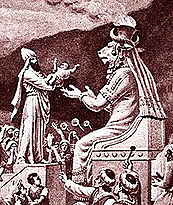
This legend of the death and burial of the sun god of Tyre is undoubtedly based upon the legend of the tomb of Bel-Marduk at Babylon. As Marduk (Bel-Baal-Lord) rose from his tomb at the New Year’s Festival…so also the Tyrians believed their sun god to come forth from his tomb, symbol of his annual sleep of death in the lower world.
At Aphaca in the Lebanons, east of Gebal, was the tomb of BAAL, who, as shall be seen, is probably Adonis of Gebal, also a sun god. The burning of the image of Melqart, the Tyrian Hercules, that by passing through the fire he may receive his youth again to revive the life of a dying world, seems to have been peculiar to Tyre and the land to which this cult spread.
It may be presumed from the human (infant-child) sacrifices to Malik (Molech) in Canaan and to Melqart (Bel-Baal-Lord) as Cronus at Carthage that the Phoenicians offered the first born in the fire which celebrated the Sol Invictus (the same Invincible Sun Constantine worshipped ) and insured themselves against the wrath of the relentless god. The Malik of Tyre was identified with Hercules…
Living infants and children were burned in the fire to the God Molech during this time. This was the time of the winter solstice when those heathen were dismayed at the signs of heaven.
Unger’s Bible Dictionary, page 416 says:
Mo¢lech (mo¢lek; Heb. Melek, king), a detestable Semitic deity honored by the sacrifice of children, in which they were caused to pass through or into the fire.
Mo¢loch (mo¢lok), another form in English (Amos 5:26; Acts 7:43) of Molech (q. v.).
.The Concise Encyclopedia of Greek and Roman Mythology, by Sabine G. Ostwalt, page 261, under Saturnus we find:
A Sacrifice was made to Saturnus… After the Sacrifice there was a public banquet…People exchanged presents, most frequently clay puppets (dolls) in memory of the fact Hercules abolished human sacrifice when he introduced the cult of Saturnus.
.The Encyclopedia Britannica, Eleventh Edition, under Saturnalia, says:
“These dolls were especially given to children and the makers of them held a regular fair at this time.”
It was believed that these dolls represented the original sacrifices to the infernal God. This infernal God was the original Molech that the Greeks renamed Cronus and the Romans renamed Saturnus. Under the earliest Romans, the Saturnalia was unified with the Brumalia—the winter solstice.
This same Babylonian worship of Molech, which came down through the Greeks and Romans, through Constantine and through the great whore of Revelation 17:1, is observed with the same practices and the same customs, at the same time of year, by the whole deceived Christian world today.
Holidays Around The World, by Joseph Gaer, 1953, page 133, says:
The Old Winter Solstice
Christmas is a very old holiday.
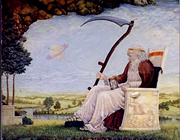
All the early nations of the earth joyfully celebrated the arrival of this season in the sun’s journey. The ancient Romans observed this time with a festivaldedicated to Saturn, the god of agriculture, and it was called Saturnalia. This festival was observed with great merriment and abandon. Gifts were exchanged. And great liberties were allowed between freemen and slaves__just as the Hindus allow the breaking of the barriers between castes on certain holidays.
When Emperor Constantine decreed Christianity as the new faith of the Roman Empire, early in the fourth century, the Christians gave the holiday an entirely new name and an entirely new meaning.
They called the holiday the Mass of Christ, or Christ Mass, which was shortened to Christmas. And they declared that Christmas was the birthday of Jesus of Nazareth. Though the exact day and year when Jesus was born are not known, tradition has set the date as December 25, 4 b.c., according to our present-day reckoning.
All of the practices of Christmas have come from paganism. They are merely the modern day practices of the same worship that Yahweh says is an abomination to Him.
New Year?
.The Book of Holidays, by J. Walker McSpadden, 1958, pages 183-184, says:

The Saturnalia was celebrated up through the Calends, or first of January, as it is still being celebrated today by the whole deceived Christian world.
Hogmany (Chag-Meni) Feast Of God Luck!
.Isayah 65:11—
But you are those who forsake Yahweh, who forget My holy mountain, who prepare a table for that troop and who furnish a drink offering for that number.
The word troop is translated from the Hebrew word gad. Unger’s Bible Dictionary, on page 415, shows us:
Gad, a Canaanite deity improperly rendered “troop” (Isa. 65:11), was the god of good fortune, supposed to be the deified planet Jupiter. This star is called by the Arabs “the greater luck” as the star of good fortune.
This word number comes from the Hebrew word mene. The Hebrew-English Lexicon of the Old Testament, by Brown, Driver, and Briggs, page 584, shows us that this word means God of fate.
Unger’s Bible Dictionary, page 416, also shows us:
Me¢ni (me¢ni; Heb. meni, destiny or fate). Name of the god of destiny or fortune worshipped by the ancient Hebrews in time of apostasy (Isa. 65:11): “But you who forsook the Lord, who forget my holy mountain, who set a table for Fortune and fill cups of mixed wine for Destiny” R. S. V. Fortune is “Gad” (q. v.) and Destiny is “Meni.” M. F. U.
What were these condemned people doing when Isayah prophesied against them? They were celebrating Christmas and New Year. The Two Babylons, by Alexander Hislop, 1959, pages 94-96, shows us:
“Christmas Day among the ancient Saxons…was observed to celebrate the BIRTH of any lord of the host of Heaven…The Saxons regarded the sun as a female god and the moon a male god. The birth of this `Lord Moon’ was on December 25th. The name of this `Lord Moon’ in the East…Babylonians, Chaldeans and among the Canaanites…was Meni – The Numberer.”
According to Hislop, Gad refers to the sun God, and Meni the moon God. The people offered sacrifices to these Gods in Isayah 65:11.
Holidays Around The World, by Joseph Gaer, 1953, page 137, says:
A Happy New Year!
Exactly one week after Christmas comes New Year’s Day. In the minds of many people these two holidays seem to go together as if they had something in common. Actually, of course, there is no relationship between them. Christmas is a deeply religious holiday, whereas New Year’s Day does nothing more than mark the beginning of the civil year.
The date we celebrate as New Year’s, like the date of Christmas, is an inheritance from the Romans.
Hogmanay means feast of the numberer. It is the feast of the God Meni. Even in this age the deceived world bows down on New Year’s Day, to Gad and Meni the Gods of luck and fortune, just as they did when Isayah prophesied against them in his day. Spreading a feast of luxuriant `lucky’ foods and toasting drink offerings to `good luck’ still takes place in Christendom today on the evening before New Year’s Day.
Collier’s Encyclopedia, Volume 6, 1980, page 404, tells us:
Gifts and Cards. The practice of exchanging presents at Christmas stems from the ancient Roman custom called Strenae. During the Saturnalia Roman citizens used to give “good luck” gifts (strenae) of fruits, pastry, or gold to their friends on New Year’s Day.
These `good luck’ gifts are in honor of the Gods of fortune and destiny The Book of Holidays, by J. Walker McSpadden, pages 7-8, says:
NEW YEAR’S DAY
Both on the Eve and on the Day we indulge in the old, old custom of “Wassail.” This universal toast comes from the old Gaelic words, was hael, meaning “good health,” and signifies the special food and drink with which we wish each other well at this time. In Scotland and northern England wassail cakes and wassail bowls are still called by that name.
An entire book, instead of a chapter, could be written on the omens and rituals of New Year’s Day throughout the ancient and modern world.
There is no question that the first day of the pagan new year is spent in acquiring `good luck’ from the Gods of luck—fortune and destiny.
There is also no question that the ancient festivities of Saturnalia—Brumalia—Chag Meni are nothing more than the Christmas—New Year of today. Christmas and New Year are still the ancient pagan worship of the ancient pagan Gods Yahweh tells us is an abomination to Him.
Janus: The God of January
.Holidays Around the World, by Joseph Gaer, pages 138-139, says:
Two-faced Janus
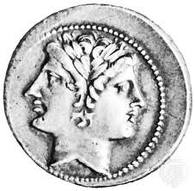
A great temple with immense gates was built to Janus. And when Rome was at war, the gates of the temple of Janus stood open. But when peace was declared, the gates were closed with great rejoicing.
There was also great rejoicing before the gates of the temple of Janus on New Year’s Day when the people gathered to do homage to the god of all beginnings. Gifts were exchanged among friends. Resolutions to be friendly and good to each other were made. And the entire day was given to festivities.
When the Romans under Constantine accepted Christianity as their new faith, they retained the Festival of Janus as their New Year’s Day.
.The Two Babylons, by Alexander Hislop, 1959, pages 209-210, tells us about the key of Janus:
When the Pope came, as he did, into intimate connection with the Pagan Priesthood; when they came under his control, what more natural than to seek not only to reconcile paganism and Christianity, but to make it appear that the pagan, `Peter-Roma’, with his `keys‘ meant `Peter of Rome‘ and that `Peter of Rome’ was the very Apostle to whom Jesus gave “the keys of the kingdom?” Hence, from the mere jingle of words, persons and things essentially different were confounded; and paganism and Christianity jumbled together, that the towering ambition of a wicked priest might be gratified; and so…to the blinded Christians of the apostasy, thePope was the representative of Peter the Apostle…while to the initiated pagans..he was only the representative of Peter…the interpreter of their well known Mysteries. Thus was the Pope the express counterpart of “Janus, the double-faced.”
Janus, the God that the month of January is named for was the father of the Gods, and at the same time the mediatorial divinity. He is identified with Bacchus or Adonis (the Sun God) and was invoked in the religion of mystery as Satur, Saturn, Mystery. The Two Babylons, page 269, says:
As MYSTERY signifies the HIDDEN SYSTEM so SATURN signifies the HIDDEN GOD.
This hidden God is the same God this whole deceived world worships today in the celebrations called Christmas and New Year.
Collier’s Encyclopedia, 1980, Volume 20, page 449, shows us who Saturn is:
SATURN
Saturn is identified with Kronos, the father of the Gods. A Dictionary of Non-Christian Religions, Geoffrey Parrinder, 1971, page 157, says: “Kronos, time in ancient Greek mythology…”
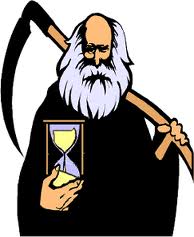
According to a different tradition, Cronos had not been a grim tyrant but a benign ruler who presided over a blessed golden age; after his deposition he left to become ruler of the Isles of the Blessed in the Western Ocean. This aspect of Cronos links him with Saturn, the Roman god with whom he was identified. Some Greeks associated Cronos’ name, wrongly, with the word chronos (time), and consequently depicted him as an old man with a scythe – Father Time. The oldest account of the story of Cronos is given by Hesiod in the Theogany.
Saturnus and Kronos are one and the same God. The Concise Encyclopedia of Greek and Roman Mythology, page 261, says this about Saturnus:
…an ancient agricultural deity who came to Rome from Etruria. But he was very early identified with the Greek-Cronus …Saturnus introduced the cultivation of the vine and taught them to use a sickle for reaping corn; hence…his statue held a sickle.
The modern version of “father time” is that of an old man with a sickle (representing the old year) who dies at the year’s end and is immediately reborn as an infant in the new year.
Mythology of All Religions, Volume 5, page 52, shows that Kronus is the ancient prototype of this modern holiday:
Bel-Melqart (Kronus)…renews himself each year as the `Invincible Sun’ in the fires that burned the infants and children to the god – Molech!
.A Dictionary of Non-Christian Religions, by Geoffrey Parrinder, 1971, page 246, says:
Saturn, Saturnalia. Saturn was a Roman god, perhaps of autumn sowing, and identified with the Greek Kronos (q.v.). His festival, the Saturnalia, was on 17 December, when there was considerable licence. Slaves could do as they liked, for a time. There was a Lord of Misrule, and presents were exchanged. Some of this was transferred into Christmas and New Year festivities. Saturn was also a planet from which Saturday is named.
.Strange Stories, Amazing Facts, by The Readers Digest Association, 1980, pages 283-284, tells us of some of the customs that were transferred to Christmas and New Year:
Weeklong feast
The seven days of Roman feasting were an occasion for exchanging presents__one of the pagan customs that was gladly incorporated into Christmas. Even the sternest advocates of the new faith could not eradicate the notion that Saturnalia was a time for merrymaking.
The Romans used to switch roles with their slaves, who were encouraged to elect their own “king” for the holiday. He would preside over a great banquet, at which the master would wait on him and his fellow servants.
A similar idea survives in the armed forces in Britain, where it is still an honored tradition for the officers and senior NCO’s to serve the Christmas dinner in the lower ranks’ mess. The reason Christian practice could never go the whole way with the Roman custom is that the unfortunate slave “kings,” after their brief exaltation, were put to death.
When the Normans invaded England in 1066, they introduced into the Christmas festivities a mock king, called the Lord of Misrule, whose job was to ensure that the celebrations were conducted in the old pagan style.
Wearing paper hats and using firecrackers are throwbacks to the wilder excesses of ancient Rome. Yule logs and candles belong to the Norse tradition: They were symbols of fire and light, bringing welcome relief in the cold and darkness of the northern midwinter.
In the centuries that followed the Norman Conquest, as Christianity gained a firmer hold, carols and the Nativity play were added. And Father Christmas evolved as a mixture of the red-robed Lord of Misrule and St. Nicholas (Santa Claus), the patron saint of children.

Mistletoe, a plant sacred to the Druids, was hung outside Viking homes as a sign of peace and welcome to strangers.
The custom of kissing under the mistletoe has been traced to the Roman Saturnalia. It has also been associated with certain primitive marriage rites.
It is a proven fact that the festivities of Christmas and New Year are the same worship to the same pagan Gods which Yahweh tells us is an abomination to Him. Yahweh also says to us in:
.Yeremyah 10:2-5—
2 This is what Yahweh says: Do not learn the way; religious practices, of the heathen; Gentile nations; and do not be deceived by the signs of heaven; though the heathen are deceived by them; using them to set their feasts.
3 For the religious customs of the peoples are vain; worthless! For one cuts a tree out of the forest, the work of the hands of the workman, with the ax.
4 They decorate it with silver and with gold; they fasten it with nails and with hammers, so that it will not move; topple over.
5 They are upright, like a palm tree, but they cannot speak; they must be carried, because they cannot go by themselves. Do not give them reverence! They cannot do evil, nor is it in them to do Righteousness!
Yahweh has told us emphatically, “Do not learn the way of the heathen!” The way of the heathen is written in the chapters of man’s customs and traditions that have come down from the mythological Semiramis – Tammuz/mother – son adoration or worship.
Yahweh’s Way is written in the Holy Scriptures. His way is there for His House to read and then to obey.
.Deuteronomy 4:1-2—
1 Hear now, O Israyl, the Statutes and the Judgments which I teach you to observe and do, that you may live, and go in and possess the land which Yahweh, the Heavenly Father of your fathers, is giving you.
2 You shall not add to the word which I command you, nor shall you take anything from it, so that you may keep the Laws of Yahweh your Father which I command you.

The worldly preachers who claim to follow the Scriptures are afraid to condemn these pagan practices. They are afraid of upsetting all the rich merchants who benefit during the yule-tide season. They are afraid of upsetting the worship of the sun that brings them so much wealth.
.II Corinthians 11:14-15—
14 And no marvel; for Satan herself is transformed into an angel of light.
15 Therefore, it is no great thing if her ministers also are transformed as the ministers of Righteousness__whose end will be according to their works.
Satan makes the emotional holidays at this time of the year seem so right. But to know these customs and traditions are the worship of pagan Gods and then to still willfully participate in them is an abominable sin.
.Hebrews 10:26—
For if we sin willfully after we have received the knowledge of the Truth, there no longer remains a sacrifice for sins.
To know that these Christian holidays of Christmas and New Year are nothing more than the worship of ancient pagan Gods is to also know that to bow down and worship them is breaking the first two of the Ten Commandments.
The First Commandment is that Yahweh is our Heavenly Father and we are to have no hinder Gods at all,
(Exodus 20:2-3).
The Second Commandment is that we are not to make any carved image in the form of anything in heaven, on earth, or in the waters, to bow down and serve them. (Exodus 20:4-5).
To bow down and serve Yahweh is to obey every Word that proceeds out of His Mouth, not adding to it nor diminishing from it in any way.
All one needs to do in order to serve hinder Gods is to turn from Yahweh’s Way. Do not be mistaken, Yahweh is alive and sees all. Yahweh is the rewarder of those that diligently seek Him.
.Hebrews 11:6—
But without the Faith it is impossible to please Him; for he who comes to Yahweh must believe that He is, and that He is a rewarder of those who diligently seek Him.

.Deuteronomy 12:30-32—
30 Be careful not to be ensnared into following them by asking about their Gods (elohim), saying: How did these nations serve their Gods (elohim)? I also will do the same.
31 You must not worship Yahweh your Father in their way, for every abomination to Yahweh, which He hates, they have done to their Gods (elohim). They even burn their sons and daughters in the fire as sacrifices to their Gods (elohim).
32 Whatsoever I command you, be careful to observe and do it, you shall not add to it, nor take away from it.
Yahweh also shows us the judgment of the religious system of mystery Babylon the great, mother of harlots and abominations of the earth.
.Revelation 18:2,8—
2 And he cried mightily with a strong voice, saying: Babylon the great is fallen, is fallen, and is become the habitation of demons, and the hold of every foul spirit, and a cage of every unclean and hateful bird.
8 Therefore, her plagues will come in one day—death, and mourning, and famine; and she will be utterly burned with fire; for strong is Father Yahweh Who judges her.
To those of Yahweh’s House whom He has called or is calling in these Last Days, to all who would enter into His Kingdom, Yahweh says:
.Revelation 18:4—
And I heard another voice from heaven, saying: Come out of her, My People, so that you do not partake in her sins, and so that you do not receive of her plagues.
Yahweh promises to His Servants, those who obey every Word that proceeds from His Mouth:
.Isayah 65:13-15—
13 Therefore, this is what Yahweh our Father says: Behold, My Servants will eat, but you will be hungry. Behold, My Servants will drink, but you will be thirsty. Behold, My Servants will rejoice, but you will be ashamed.
14 Behold, My Servants will sing for joy of heart, but you will cry for sorrow of heart, and wail for vexation; grief, of spirit;
15 And the names of your Gods (elohim) will remain as a trap; test, to My Chosen; for it will truly come to pass that you will be judged, and you will die, but Yahweh will give His Servants a Name; Yahweh, that will remain forever.
.Revelation 21:5-8—
5 And He Who sat upon the throne, said: Behold, I make all things new. And He said to me: Write, for these Words are True and Faithful.
6 And He said to me: It is done! I am Aleph and Tau, the Beginning and the End. I will give to him who thirsts of the fountain of the water of life freely.
7 He who overcomes will inherit all things; and I will be his Father, and he will be My son.
8 But the fearful, and unbelieving, and the abominable, and murderers, and whoremongers, and sorcerers, and worshipers of Gods (elohim), and all liars, will have their part in the lake which burns with fire and brimstone—which is the second death.
.Revelation 22:13-17—
13 I am the First and the Last, the Beginning and the End.
14 Blessed are those who keep His Laws, that they may have right to the Tree of Life, and may enter in through the Gates into the City.
15 For outside are dogs, and sorcerers, and whoremongers, and murderers, and worshipers of Gods (elohim) and everyone who professes to love, yet practices breaking the Laws.
16 I, Yahshua, have sent My Malak to testify to you these things in the congregations of The House of Yahweh. I am the Root and the Offspring of David, and the Bright and Morning Star.
17 And the Spirit and the bride, say: Come! And let him who hears, say: Come! And let him who is thirsty come. And whoever will, let him take the water of life freely.
Personal Note from the Editor about Christmas And New Year
When most people first begin to study their bible for themselves, they are shocked to find that their bible does not say what their church teaches.
Every honest bible student who has studied the bible for any length of time will admit that there has been vast changes in doctrine from the time of the early followers of Yahshua. These students may not all agree on the times these changes took place, but they will all agree that this did take place.
In The New International Dictionary of the Christian Church, Revised Edition, by Zondervan Publishing, on page 222, we find this statement concerning the Disciples who were personally taught by Yahshua:
CHRISTIAN YEAR, THE. The early Christians who were mainly Jews were used not only to keeping one day in the week as separate but also to marking the year with certain religious festivals, notably Passover, Tabernacles, and Pentecost. From early times Christians kept a commemoration of Christ’s resurrection. This was held at Passover time and was finally fixed on the Sunday following Passover. Pentecost was then celebrated at the appropriate time; the fifty days between the two were days of joy and rejoicing. The choice of 25 December (in the East, 6 January) for the birth of Christ is almost certainly because that day was the great pagan day of honor to the sun, and in Rome in the fourth century it was transformed into a Christian festival.
From the fourth century the Christian calendar became more historical in character, and Holy Week and Ascension Day appeared. Pentecost became the day of the giving of the Holy Spirit. Lent arose out of the custom of preparing catechumens for baptism at Easter. Saints’ days came into the calendar either through the commemoration of a martyrdom or through the date of a dedication of a church in honor of a particular saint. The advantage of the Christian Year is that through the church services, and in particular the choice of Scripture passages to be read, worshipers are regularly reminded of the great events of the Christian faith and a balance is kept between them. In recent years there have been various suggestions for modification of the calendar, particularly in relation to Advent and Lent, and some demand, supported by secular sources, for a fixed date for Easter.
Peter S. Dawes
Please note when these changes appeared on the pages of man’s history. Also note that, the followers of Yahshua, the Disciples and early believers, did not celebrate these pagan days. Do not be deceived, these pagan celebrations were being observed even during the time of the Apostles, but Yahweh’s People did not observe any of these pagan celebrations.
The Apostles and early believers kept the commanded Holy Days of Yahweh—the weekly Sabbath, Yahshua’s Memorial, the Passover and Feast of Unleavened Bread, the Day of Pentecost, the Feast of Trumpets, the Day of Atonement, the Feast of Tabernacles and the Last Great Day.
The Apostle Shaul warned the flock of Yahweh of the changes that he knew would take place in:
.Acts 20:29-32—
29 For I know this, that after my departing grievous wolves will enter in among you, not sparing the flock.
30 Also among your own selves will men arise, speaking perverse things, to draw away disciples after themselves.
31 Therefore watch, and remember, that for the period of three years I did not cease to warn everyone night and day with tears.
32 And now, brothers, I commend you to Yahweh, and to the Laws which He gave, which are able to build up The House of Yahweh, and are able to give you an inheritance among all those who are Saints.
Shaul knew Yahweh’s Way of Salvation would be rejected by ones there. He knew these people would turn back to the pagan worship he had taught against for three years. He warned them night and day with tears.
Shaul knew that only Yahweh’s Way of Salvation was able to build one up to the inheritance of Eternal Life, as he said in:
.Acts 20:32—
…which are able to build up The House of Yahweh, and are able to give you an inheritance among all those who are Saints.
Sanctified means to be set apart for a holy purpose. Shaul knew that only the Way of Yahweh would sanctify a person and give that person the right to the Tree of Life.
.Revelation 22:14—
Blessed are those who keep His Laws, that they may have right to the Tree of Life, and may enter in through the Gates into the City.
The Apostles and early believers never taught the pagan custom of Christmas. This deception was brought into the congregations after the death of the Apostles.
This celebration was not a new doctrine by any means. The pagans had been practicing these celebrations hundreds of years before Yahshua was born!
These celebrations were condemned by the early Prophets. Yeremyah had this to say about the pagan celebration which early Christians renamed Christmas:
.Yeremyah 10:1—
Hear the word which Yahweh speaks concerning you, O house of Israyl.
The world does not hear Yahweh’s Words. The reason this world does not hear the Word of Yahweh is because Satan has deceived this whole world, as we are told in Revelation 12:9. Our Savior also said in:
.Mattithyah 13:13—
That is why I speak to them in parables; because seeing they do not see, and hearing they do not hear, nor do they understand.
Yahweh’s Word is very clear. The world knows what the Prophets have written, they even believe the Prophets spoke these things; yet they do not practice what the Prophets under Yahweh’s Inspiration taught, as we see written in:
.Yeremyah 10:2—
This is what Yahweh says: Do not learn the way; religious practices, of the heathen; Gentile nations; and do not be deceived by the signs of heaven; though the heathen are deceived by them; using them to set their feasts.
The people of this world have disobeyed Yahweh not only by learning heathen ways, but also by practicing these heathen ways yearly.
.Yeremyah 10:3—
For the religious customs of the peoples are vain; worthless!…
Notice what Yahweh says in Yeremyah 10:3. This custom that all the world practices is a vain custom. This custom will not bring Salvation, but its vanity will most definitely bring death. We are also told in Yeremyah what this vain custom is that Yahweh tells us not to learn:
.Yeremyah 10:3-5—
3 …For one cuts a tree out of the forest, the work of the hands of the workman, with the ax.
4 They decorate it with silver and with gold; they fasten it with nails and with hammers, so that it will not move; topple over.
5 They are upright, like a palm tree, but they cannot speak; they must be carried, because they cannot go by themselves. Do not give them reverence! They cannot do evil, nor is it in them to do Righteousness!
This vain custom that Yahweh commands us not to learn is practiced by all of Christendom every year. They cut their evergreen trees and they deck their trees just as they did in the time of Yeremyah. This world thinks nothing of practicing this vain custom, although it is a custom of worship to pagan Gods! The practice of this vain custom also breaks the First Commandment: “I am Yahweh, you shall have no hinder Gods.”
The breaking of Yahweh’s Laws is sin (I Yahchanan 3:4). The wages you earn for practicing sin is death (Romans 6:23)! This world believes the fact that Yahweh inspired these Scriptures to be written. His Words are there for all to read, but they refuse to believe what Yahweh says. Yahweh says throughout the Scriptures that this vain way leads to death, and if you practice these vain customs which Satan instituted, you are a servant of Satan and not of Yahweh.
.Romans 6:16—
Do you not know that to whom you yield yourselves as servants to obey, his servants you are whom you obey—whether of sin, which leads to death, or of obedience, which leads to Righteousness?
.Yeremyah 10:2—
This is what Yahweh says: Do not learn the way; religious practices, of the heathen; Gentile nations; and do not be deceived by the signs of heaven; though the heathen are deceived by them; using them to set their feasts.
It was through ignorance, and the dread and fear of the signs of a dying sun, that this vain custom of Christmas was introduced, though it was not called Christmas at that time. What is even more amazing is the fact that today’s educated world still worships Satan through these vain customs that pagans practiced because of their ignorance.
.Revelation 21:7-8—
7 He who overcomes will inherit all things; and I will be his Father, and he will be My son.
8 But the fearful, and unbelieving, and the abominable, and murderers, and whoremongers, and sorcerers, andworshipers of Gods (elohim), and all liars, will have their part in the lake which burns with fire and brimstone—which is the second death.
.Yeremyah 10:8—
But they are altogether senseless; as one They are consumed by their foolishness; their stock is a doctrine of vanities; preaching about worthless Gods (elohim, teraphim) made of wood!
This custom practiced during this month of the year is not a new doctrine ordained by any of the followers of Yahweh. This custom named Christmas is an old, pagan practice from the worship of Baal.
The Apostles warned against and taught against this pagan practice. However, this pagan practice was brought back into the congregations by the Christians who claimed they were following the Apostles—by men whom Shaul described as grievous wolves in Acts 20:29.
The New International Dictionary of the Christian Church, Zondervan, page 223, says this about this vain custom:
CHRISTMAS. The English name for the Feast of the Nativity of Christ kept on 25 December by the Western Church. There is no evidence of a Feast of the Nativity before the fourth century, except possibly among the Basilidians. The earliest mention of 25 December is in the Philocalian Calendar, compiled in 354, which cites its observance in Rome in 336. It would not appear to have been celebrated in Antioch until approximately 375. By 380 it was being observed in Constantinople, and by 430 in Alexandria. It was still unknown in Jerusalem early in the fifth century – it was not until the sixth century that the Nativity was finally detached from 6 January and celebrated on 25 December. By the middle of the fifth century – it was being gradually observed throughout East and West. The Armenians still observe 6 January, the closely related Feast of the Epiphany, as Christmas Day.
There is no authoritative historical evidence as to the day or month of Christ’s birth in Jerusalem. 25 December was the date of a Roman pagan festival inaugurated in 274 as the birthday of the unconquered sunwhich at the winter solstice begins again to show an increase in light. Sometime before 336 the Church in Rome, unable to stamp out this pagan festival, spiritualized it as the Feast of the Nativity of the Sun of Righteousness. Christmas in the Eastern Church celebrates the birth of Christ together with the visit of the shepherds and the adoration of the wise men. In the Western Church the adoration of the Magi is attached to Epiphany on 6 January. In the Roman Catholic Church three masses are usually said to symbolize the birth of Christ eternally in the bosom of the Father, from the womb of Mary and mystically in the soul of the faithful. The traditional customs associated with Christmas have been derived from several sources. The merrymaking and the exchange of presents find their origin in the Roman Saturnalia festival (17-24 December), and the greenery and lights come from the Kalends of January (1 January, the Roman New Year) with its solar associations. The Germano-Celtic Yule rites introduced the tradition of feasting and fellowship. In the USA (and in England during the Commonwealth) Christian celebrations were at first suppressed by the Puritans, who objected to their pagan origins. Since the nineteenth century the celebration of Christmas has become increasingly popular.
James Taylor
These pagan practices brought on the death of the first established House of Yahweh. Satan managed to slowly bring pagan practices and false doctrines into The House of Yahweh after all of the Apostles died. The Apostles fought against these practices and doctrines until their deaths.
The House of Yahweh was the Pillar and Ground of the Truth of Yahweh when it was under the direct leadership of the Apostles. When pagan practices and false doctrines entered in, those polluted assemblies were no longer the Pillar and Ground of Yahweh’s Truth.
As the Apostles would not yield to pagan customs or false doctrines, we also should not yield to churches today that teach these doctrines. Yahshua gave us this warning in:
.Yahchanan Mark 7:7—
But in vain do they worship Me, teaching as doctrine the commandments of men.
These pagan customs and practices are the worship of pagan Gods that Yahweh warned against in:
.Deuteronomy 12:30-32—
30 Be careful not to be ensnared into following them by asking about their Gods (elohim), saying: How did these nations serve their Gods (elohim)? I also will do the same.
31 You must not worship Yahweh your Father in their way, for every abomination to Yahweh, which He hates, they have done to their Gods (elohim). They even burn their sons and daughters in the fire as sacrifices to their Gods (elohim).
32 Whatsoever I command you, be careful to observe and do it, you shall not add to it, nor take away from it.
What is the way of worship that brings Salvation? Your Savior, Yahshua Messiah, through Yahweh our Father, gives you the answer—and it is not through the worship of pagan Gods.
.Mattithyah 19:17—
But He said to him: Why do you question Me about Righteousness? There is only One Who is the Standard of Perfection, and He is Yahweh; so if you would enter into Life, keep the Laws.
.Mattithyah 4:4—
But He answered, and said; It is written: Man does not live by bread alone, but by every Word (Law) that proceeds out of the Mouth of Yahweh.
Yahshua quoted Mattithyah 4:4 from the Law__Torah:
.Deuteronomy 8:3—
So He humbled you, and allowed you to hunger, and fed you with manna, which you did not know of nor did your fathers know of it; so He might make you to know that man does not live by bread only, but by every Word (Law) that proceeds out of the Mouth of Yahweh, does man live.
Pagan practices will not lead to Eternal Life. Those who follow vain customs are called whoremongers and worshipers of Gods by Yahweh. Yahweh also says such will suffer the second death in Revelation 21:8.
The only way to Everlasting Life is Yahweh’s Way. There is no other way!

The New International Dictionary Of The Christian Church, by J.D. Douglas, Zondervan Publishing, Grand Rapids, MI, 1974, page 322, gives the following information about the Christian celebration called Easter:
EASTER. The celebration of Christ’s resurrection. Although the Scriptures make no provision for the observance of Easter as the day of resurrection… Christians of the first century consciously sought to create a Christian parallel to the Jewish Passover, since the close relationship between the significance of that event in the O.T. and the crucifixion in the N.T. made a transformation of that Jewish feast into Easter both logical and easy.
After a.d. 100, Easter, Pentecost, and Epiphany became the final parts of the church year
Easter does not come from the Scriptures. This pagan custom has another source. As we have read, there was a transformation of the “Jewish” Feast (Passover) into Easter. Remember though, this was done by man and not by Yahweh. The following definitions of transform and transformation are from The Reader’s Digest Encyclopedic Dictionary, page 1422.
trans·form (v. trans·fôrm‘; n. trans‘fôrm) v.t. 1. To give a different form or appearance to. 2. To change the character, nature, condition, etc., of.
trans·for·ma·tion (trans‘fer·ma‘ shen) n. 1. Any change. 2. The act of transforming, or the state of being transformed.
We will then let the New International Dictionary Of The Christian Church, by J.D. Douglas, page 322, tell us how this transformation was accomplished in the religion called Christianity.
CHRISTIAN YEAR, THE. The early Christians who were mainly Jews were used not only to keeping one day in the week as separate but also to marking the year with certain religious festivals, notably Passover, Tabernacles, and Pentecost. From early times Christians kept a commemoration of Christ’s resurrection. This was held at Passover time and was finally fixed on the Sunday following Passover. Pentecost was then celebrated at the appropriate time; the fifty days between the two were days of joy and rejoicing. The choice of 25 December (in the East, 6 January) for the birth of Christ is almost certainly because that day was the great pagan day of honor to the sun, and in Rome in the fourth century it was transformed into a Christian festival.
From the fourth century the Christian calendar became more historical in character, and the Holy Week and Ascension Day appeared. Pentecost became the day of giving of the Holy Spirit. Lent arose out of the custom of preparing catechumens for baptism at Easter. Saints’ days came into the calendar either through the commemoration of a martyrdom or through the date of a dedication of a church in honor or a particular saint.
Why doesn’t this whole Christian world simply celebrate the Feasts, which Yahweh ordained in His Holy Scriptures, clearly written in Leviticus 23? Why would there have to be any transformation of these Feasts in the first place?
The answer to these questions lies in the early history of Christianity; specifically, at the Council of Nicea in 325 c.e. when Constantine helped to formulate Christian doctrine.
When Constantine—the only man in history who was extolled both as a Christian saint and a pagan God—presided over the Council of Nicea in 325 c.e., his main objective was political: how to merge religion and politics efficiently. Since there were more politically powerful pagans than there were politically powerful believers, the celebrations that the pagans were accustomed to observing were the celebrations which were accepted; and at the same time, the celebrations of the Jews were rejected. Reading from Funk and Wagnall’s Standard Reference Encyclopedia, Volume 8, we find the following.
An important historic result of the difference was that the Christian churches in the East, which were closer to the birthplace of the new religion, and in which old traditions were strong, observed Easter according to the date of the Passover festival, while the churches of the West, whose communicants were descendants of Græco-Roman civilization, celebrated Easter on a Sunday.
Settlement of this difference was one of the objects of the Roman emperor Constantine in convoking, in 325 a.d., the Council of Nicæa (see nicÆa, councils of).
At the Council of Nicea, it was decided that Easter should be celebrated in accordance with the Alexandrine computation. Collier’s Encyclopedia, Volume 17, page 520, gives us the following information:
NICAEA, COUNCILS OF [naisi‘ ], were two in number. (1) The first (First Ecumenical), in a.d. 325, convoked by Constantine, condemned Arianism, which was essentially a denial of the divine nature of the Word, and so of the Son of God, Christ. The traditional number of bishops present was 318 (see Genesis 14:14); the real number was probably about 270. The council defined the doctrine that the Son is consubstantial (o&moouvsioV”) with the Father. In the drawing up of the formula leading parts were taken by St. Athanasius and Hosius, bishop of Cordoba; the latter probably presided. The council promulgated the famous Nicene Creed in its original form. It also decided that Easter should thenceforth be celebrated everywhere at the same time in accordance with the Alexandrine computation.
The pagan Alexandrine computation for the setting of Easter is written in Collier’s Encyclopedia, Volume 8, page 492, which says:
EASTER, the church feast which commemorates the resurrection of Jesus Christ, is considered the most ancient and most important festival of the Christian year.
Prior to the time of Pope Victor I (189-c. 198), the Western churches as a rule kept Easter on the first day of the week, while many of the Eastern churches, conforming to the Jewish rule, observed it on the fourteenth of the month of Nisan. Through the energetic efforts of Pope Victor, the latter practice gradually disappeared. But another problem came to the fore: granted that Easter was to be kept on Sunday, how was that Sunday to be determined? The Council of Nicaea (325) paved the way for a final settlement by ruling that Easter is to be observed by all on the same Sunday, that this must be the Sunday following the fourteenth day of the paschal moon, and that that moon was to be accounted as the paschal moon whose fourteenth day followed the vernal equinox. Because of differences in the systems of chronology followed in various places, however, the decrees of Nicaea did not immediately remove all difficulties nor win universal acceptance. The Gregorian correction of the calendar in 1582, moreover, introduced still further discrepancies. Throughout Western Christendom the corrected calendar is now universally accepted, and Easter is solemnized on the first Sunday after the full moon following the vernal equinox, with the result that the earliest possible date is March 22, the latest, April 25.
The Catholic church’s justification for using the vernal equinox to set its date for Easter Sunday, which the Protestant churches have accepted completely, comes from the words of Constantine himself, at the Council of Nicea in the year 325 of this Common Era, saying:
And truly, in the first place, it seems to everyone a most unworthy thing that we should follow the customs of the Jews in the celebration of this most holy solemnity, who, polluted wretches! having stained their hands with a nefarious crime, are justly blinded in their minds. It is fit, therefore, that rejecting the practice of this people, we should perpetuate to all future ages the celebration of this rite, in a more legitimate order, which we have kept from the first day of our “Lord’s” passion even to the present times. Let us then have nothing in common with the most hostile rabble of the Jews.
The Council of Nicea, page 23, then says:
Easter day was fixed on the Sunday immediately following the full moon which was nearest after the vernal equinox, because it is certain that our Saviour rose from the dead on the Sunday which next succeeded the Passover of the Jews.
According to the calculations adopted at the Council of Nicea, which are still in effect in every Christian church and assembly in this world, we read:
If the Passover fell on a Sunday, Easter was to be the following Sunday, so as to have nothing in common with the Jews.
It was not the Jews who were being rejected. Constantine and his followers were rejecting the Laws that these people obeyed—Yahweh’s Laws which established each of the Feasts that He had ordained. Effectually, because Christianity wanted nothing in common with the Jews, they also have nothing in common with the Ordinances or Laws of Yahweh. Therefore, because Christianity has nothing in common with Yahweh and His Feasts, it has everything in common with paganism and its festivals. This fact is documented from The Interpreter’s Dictionary Of The Bible, Volume 4, page 894.
11. The church week and year. The development of the church calendar was a remarkably slow process in Christianity, and equally striking is the fact that so little of the Jewish year finally found a place in Christian celebrations. Where we should have expected a Christian transformation of Rosh Hashanah, Yom Kippur, Succoth, Chanukah, Purim, etc., we find only the retention of the paschal festival. This is due to the fact that the church year was largely the creation of the Gentile church, and the background of such notable days as Christmas, Epiphany, Ember, etc., is pagan, not Jewish.
We must, however, suppose that the earliest Christians continued to observe the Jewish year and week, until the break with the synagogue was complete. Of definitely Christian days, distinct from those of Judaism, the N.T. affords us only one certain example, that of Sunday. This was observed as the day of the Lord’s resurrection.
The Pagan Worship Of Easter
Reading from Compton’s Pictured Encyclopedia, Volume 4, page 140, we find that Easter is the greatest festival of the Christian church, which commemorates the resurrection of Jesus Christ. This festival was named after the ancient Anglo Saxon Goddess of spring.
EASTER. The greatest festival of the Christian church commemorates the Resurrection of Jesus Christ. It is a movable feast, that is, it is not always held on the same date. The church council of Nicea (a.d. 325) decided that Easter should be celebrated on the first Sunday after the first full moon on or after the vernal equinox(March 21). Easter can come as early as March 22 or as late as April 25.
The name Easter comes from the ancient Anglo-Saxon goddess of spring, Eostre or Ostara, in whose honor an annual spring festival was held. Some of our Easter customs have come from this and other pre-Christian spring festivals. Others come from the Passover feast of the Jews, observed in memory of their deliverance from Egypt (see Passover). The word “paschal,” meaning “pertaining to Easter,” like the French word for Easter, Pâques, comes through the Latin from the Hebrew name of the Passover.
.Unger’s Bible Dictionary, by Merrill F. Unger, page 283, goes on to corroborate this fact.
Easter (Gr. pascha, from Heb. pesah), the Passover, and so translated in every passage excepting “intending after Easter to bring him forth to the people” (Acts 12:4). In the earlier English versions Easter had been frequently used as the translation of pascha. At the last revision Passover was substituted in all passages but this. See Passover.
The word Easter is of Saxon origin, Eastra, the goddess of spring, in whose honor sacrifices were offered about Passover time each year. By the 8th century Anglo-Saxons had adopted the name to designate the celebration of Christ’s resurrection.
It is a fully documented historical fact that the day which was chosen by the Christian church to celebrate this resurrection, was a day which had been celebrated by pagans from antiquity. Yes, the only difference between these two celebrations, is the fact that its name was changed to veneer it with “Christian respectability”.
It is simply no secret that Easter originated with the worship of a pagan Goddess. This fact is presented almost every time one researches the word Easter.
Compton’s Encyclopedia, Volume 4, says the following about Easter:
“Many Easter customs come from the Old World…colored eggs and rabbits have come from pagan antiquity as symbols of new life…our name `Easter’ comes from `Eostre’, an ancient Anglo Saxon goddess, originally of the dawn. In pagan times an annual spring festival was held in her honor. Some Easter customs have come from this and other pre-christian spring festivals.”
Reading about this pre-Christian spring festival from Funk & Wagnall’s Standard Reference Encyclopedia, Volume 8, page 294, we learn:
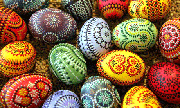
Such festivals, and the myths and legends which explain their origin, abounded in ancient religions. The Greek myth of the return of the earth-goddess Demeter from the underworld to the light of day, symbolizing theresurrection of life in the spring after the long hibernation of winter, had its counterpart, among many others, in the Latin legend of Ceres and Persephone. The Phrygians believed that their all-powerful deity went to sleep at the time of the winter solstice, and they performed ceremonies at the spring equinox to awaken him with music and dancing. The universality of such festivals and myths among ancient peoples has led some scholars to interpret the resurrection of Christ as a mystical and exalted variant of fertility myths.
.The Dictionary of Mythology, Folklore, and Symbols, Part 1, page 487 tells us more about this spring festival.
“It incorporates some of the ancient Spring Equinox ceremonies of sun worship in which there were phallic rites and spring fires, and in which the deity or offering to the deity was eaten…The festival is symbolized by anascension Lily…a chick breaking its shell, the colors white and green, the egg, spring flowers, and the rabbit.The name is related to Astarte, Ashtoreth, Eostre and Ishtar, goddess who visited and rose from the underworld. Easter yields `Enduring Eos’… `Enduring Dawn’.”
Part of this spring festival centered around phallic rites. Collier’s Encyclopedia, 1980, Volume 9, page 622, tells us of the Babylonian Ishtar festival phallic rites.
The Ishtar Festivals were symbolical of Ishtar as the goddess of love or generation. As the daughter of Sin, the moon god, she was the Mother Goddess who presided over child birth; and women, in her honor, sacrificed their virginity on the feast day or became temple prostitutes, their earnings being a source of revenue for the temple priests and servants.
We learn about these temple prostitutes from The Interpreter’s Dictionary of The Bible, Volume 3, pages 933-934:
a. The roll of the sacred prostitute in the fertility cult. The prostitute who was an official of the cult in ancient Palestine and nearby lands of biblical times exercised an important function. This religion was predicated upon the belief that the processes of nature were controlled by the relations between gods and goddesses. Projecting their understanding of their own sexual activities, the worshipers of these deities, through the use of imitative magic, engaged in sexual intercourse with devotees of the shrine, in the belief that this would encourage the gods and goddesses to do likewise. Only by sexual relations among the deities could man’s desire for increase in herds and fields, as well as in his own family, be realized. In Palestine the gods Baal and Asherah were especially prominent (see BAAL; ASHERAH; FERTILITY CULTS). Attached to the shrines of these cults were priests as well as prostitutes, both male and female. Their chief service was sexual in nature– the offering of their bodies for ritual purposes.
Sexual relations for ritual purposes was the ceremony for the fertility cults. The Interpreter’s Dictionary, Volume 2, page 265 says:
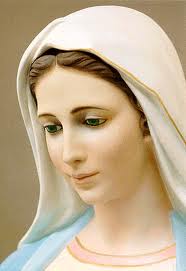
The great mother-goddess Asherah, the wife of the senescent chief god El, seems on the way to becoming the consort of the rising young god Baal, with whom we find her associated in the O.T. Ashtarte also appears in the Ugaritic myths, but she has a minor and undistinguished role.
The O.T. furnishes abundant evidence as to the character of the religion of the land into which the Israelites came. Fertility rites were practiced at the numerous shrineswhich dotted the land, as well as at the major sanctuaries. The Israelites absorbed the Canaanite ways and learned to identify their god with Baal, whose rains brought fertility to the land. A characteristic feature of the fertility cult was sacral sexual intercourse by priests and priestesses and other specially consecrated persons,sacred prostitutes of both sexes, intended to emulate and stimulate the deities who bestowed fertility. The agricultural cult stressed the sacrifice or common meal in which the gods, priests, and people partook. Wine was consumed in great quantity in thanksgiving to Baal for the fertility of the vineyards. The wine also helped induce ecstatic frenzy, which was climaxed by self-laceration, and sometimes even by self-emasculation.Child-sacrifice was also a feature of the rites. It was not simply a cult of wine, women, and song, but a matter of life and death in which the dearest things of life, and life itself, were offered to ensure the ongoing of life.
Reading on page 103 of The Two Babylons, by Alexander Hislop, we find that Easter and Ishtar are the same.
Then look at Easter. What means the term Easter itself? It bears its Chaldean origin on its very forehead.Easter is nothing else than “Astarte”, one of the titles of Beltis, “The Queen of Heaven” whose name, as “pronounced” by the people of Nineveh, was evidently identical with that now in common use in this country. That `name’, as found by Layard on the Assyrian monuments, is “Ishtar”.
Ishtar or Easter of Assyria was worshiped in pagan antiquity during her spring festival. Collier’s Encyclopedia, Volume 15, page 748, gives us the following information.
Ishtar, goddess of love and war, the most important goddess of the Sumero-Akkadian pantheon. Ishtar was equated with the planet Venus. As goddess of physical love, she was patron of the temple prostitutes. She was also considered the merciful mother who intercedes with the gods on behalf of her worshipers. Throughout Mesopotamian history she was worshiped under various names in many cities…
Astarte of Phoenicia was the offshoot of Ishtar of Assyria. To the Hebrews, this abomination was known as Ashtoreth/Ashtaroth. From Collier’s Encyclopedia, Volume 3, page 13, we read:
ASHTAROTH [梑òterath] the plural of the Hebrew `Ashtoreth, the Phoenician-Canaanite goddess Astarte, deity of fertility, reproduction, and war.
.Watson’s Biblical and Archaeological Dictionary, 1833, tells us more about this mother Goddess, Ashtaroth.
ASHTAROTH, or ASTARTE, a goddess of the Zidonians. The word Ashtaroth properly signifies flocks of sheep, or goats; and sometimes the grove, or woods, because she was goddess of woods, and groves were her temples. In groves consecrated to her, such lasciviousness was committed as rendered her worship infamous. She was also called the queen of heaven; and sometimes her worship is said to be that of “the host of heaven.” She was certainly represented in the same manner as Isis, with cow’s horns on her head, to denote the increase and decrease of the moon.
.The Interpreter’s Dictionary, Volume 3, page 975, tells us of Ishtar’s role as the Queen of Heaven:
Ishtar, the goddess of love and fertility, who was identified with the Venus Star and is actually entitled “Mistress of Heaven” in the Amarna tablets. The title “Queen of Heaven” is applied in an Egyptian inscription from the Nineteenth Dynasty at Beth-shan to “Antit,” the Canaanite fertility-goddess Anat, who is termed “Queen of Heaven and Mistress of the Gods.” This is the most active goddess in the Ras Shamra Texts, but in Palestine her functions seem to have been taken over largely by Ashtoreth.
We find the following information about Ashtoreth from The International Standard Bible Encyclopedia, Volume 1, pages 319-320.
ASHTORETH ash‘te-reth [Heb. `astoret. pl. `astarôt; Gk. Astarte]. A goddess of Canaan and Phoenicia whose name and cult were derived from Babylonia, where Ishtar represented the evening and morning stars and was accordingly androgynous in origin. Under Semitic influence, however, she became solely female, although retaining a trace of her original character by standing on equal footing with the male divinities. From Babylonia the worship of the goddess was carried to the Semites of the West, and in most instances the feminine suffix was attached to her name; where this was not the case the deity was regarded as a male. On the Moabite Stone, for example, ‘Ashtar is identified with Chemosh, and in the inscriptions of southern Arabia `Athtar is a god. On the other hand, in the name Atargatis (2 Macc. 12:26), `Atar, without the feminine suffix, is identified with the goddess `Athah or `Athi (Gk. Gatis). The cult of the Greek Aphrodite in Cyprus was borrowed from that of Ashtoreth; that the Greek name also is a modification of Ashtoreth is doubtful. It is maintained, however, that the vowels of Heb. `astoret were borrowed from boset (“shame”) in order to indicate the abhorrence the Hebrew scribes felt toward paganism and idolatry.
In Babylonia and Assyria Ishtar was the goddess of love and war. An old Babylonian legend relates how thedescent of Ishtar into Hades in search of her dead husband Tammuz was followed by the cessation of marriage and birth in both earth and heaven; and the temples of the goddess at Nineveh and Arbela, around which the two cities afterward grew, were dedicated to her as the goddess of war. As such she appeared to one of Ashurbanipal’s seers and encouraged the Assyrian king to march against Elam. The other goddesses of Babylonia, who were little more than reflections of a god, tended to merge into Ishtar, who thus became a type of the female divinity, a personification of the productive principle in nature, and more especially the mother and creatress of mankind.
In Babylonia Ishtar was identified with Venus. Like Venus, Ishtar was the goddess of erotic love and fertility. Her chief se at of worship was Uruk (Erech), where prostitution was practiced in her name and she was served with immoral rites by bands of men and women. In Assyria, where the warlike side of the goddess was predominant, no such rites seem to have been practiced, and instead prophetesses to whom she delivered oracles were attached to her temples.
From various Egyptian sources it appears that Astarte or Ashtoreth was highly regarded in the Late Bronze Age.
Reading on pages 412-413 of Unger’s Bible Dictionary, we find the following information about Ashtoreth/Astarte.
Ash‘toreth (ash‘to-reth), Astarte, a Canaanite goddess. In south Arabic the name is found as `Athtar (apparently from `athara, to be fertile, to irrigate), a god identified with the planet Venus. The name is cognate with Babylonian Ishtar, the goddess of sensual love, maternity and fertility. Licentious worship was conducted in honor of her. As Asherah and Anat of Ras Shamra she was the patroness of war as well as sex and is sometimes identified with these goddesses.
.Unger’s Bible Dictionary, page 412, gives us the following information about Asherah.
Asherah (a-she‘ra), plural, Asherim, a pagan goddess, who is found in the Ras Shamra epic religious texts discovered at Ugarit in North Syria (1929-1937), as Asherat,”`Lady of the Sea” and consort of El. She was the chief goddess of Tyre in the 15th century b.c. with the appellation Qudshu, “holiness.” In the Old Testament Asherah appears as a goddess by the side of Baal, whose consort she evidently came to be, at least among the Canaanites of the South. Other names of this deity were Ashtoreth (Astarte) and Anath. Frequently represented as a nude woman bestride a lion with a lily in one hand and a serpent in the other, and styledQudshu “the Holiness,” that is, “the Holy One” in a perverted moral sense, she was a divine courtesan. In the same sense the male prostitutes consecrated to the cult of the Qudshu and prostituting themselves to her honor were styled qedishim, “sodomites” (Deut. 23:18; 1 Kings 14:24; 15:12; 22:46). Characteristically Canaanite the lily symbolizes grace and sex appeal and the serpent fecundity (W. F. Albright, Archaeology and the Religion of Israel, Baltimore, John Hopkins Press, 1942, pages 68-94). At Byblos (Biblical Gebal) on the Mediterranean, north of Sidon, a center dedicated to this goddess has been excavated. She and her colleagues specialized in sex and war and her shrines were temples of legalized vice. Her degraded cult offered a perpetual danger of pollution to Israel and must have sunk to sordid depths as lust and murder were glamorized in Canaanite religion.
Astarte is the Greek name for the Hebrew Ashtoreth. From Collier’s Encyclopedia, Volume 3, page 97, we find that Astarte/Ashtaroth is merely the Semitic Ishtar—which we have already learned is Easter.
ASTARTE [æsta‘rti], the Phoenician goddess of fertility and erotic love. The Greek name, “Astarte” was derived from Semitic, “Ishtar,” “Ashtoreth.” Astarte was regarded in Classical antiquity as a moon goddess, perhaps in confusion with some other Semitic deity. In accordance with the literary traditions of the Greco-Romans, Astarte was identified with Selene and Artemis, and more often with Aphrodite. Among the Canaanites, Astarte, like her peer Anath, performed a major function as goddess of fertility.
Egyptian iconography, however, portrayed Astarte in her role as a warlike goddess massacring mankind, young and old. She is represented on plaques (dated 1700-1100 b.c.) as naked, in striking contrast to the modestly garbed Egyptian goddesses. Edward J. Jurji
In Ephesus from primitive times, this mother Goddess had been called Diana, who was worshiped as the Goddess of virginity and motherhood. She was said to represent the generative powers of nature, and so was pictured with many breasts. A tower shaped crown, symbolizing the tower of Babylon, adorned her head:
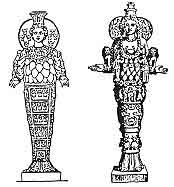
“The circle round her head denotes the nimbus (sin circle) of her glory, the griffins inside of which express its brilliancy. In her breasts are the twelve signs of the zodiac, of which those seen in front are the ram, bull, twins, crab, and lion; they are divided by the hours. Her necklace is composed of acorns, the primeval food of man. Lions are on her arms to denote her power, and her hands are stretched out to show that she is ready to receive all who come to her. Her body is covered with various breasts and monsters, as sirens, sphinxes, and griffins, to show that she is the source of nature, the mother of all things. Her head, hands, and feet are of bronze while the rest of the statue is of alabaster to denote the ever-varying light and shade of the moon’s figure… Like Rhea, she was crowned with turrets, to denote her dominion over terrestrial objects.”
The Original Goddess Semiramis Of Babylon
The worship of Ishtar/Easter spread throughout the ancient pagan world, where she was venerated in almost every segment of society. The original of this Goddess, however, loomed upon the historical scene in Babylon. From The Two Babylons by Hislop, pages 20-22, we find this information about the original of this great mother Goddess—Semiramis.
The Babylonians in their popular religion, supremely worshiped a Goddess Mother, and a Son, who was represented in pictures and in images as an infant or child in his mother’s arms. From Babylon, this worship of the Mother and the Child spread to the ends of the earth. …the Jesuit missionaries were astonished to find the counterpart of Madonna ** and her child as devoutly worshiped as in Papal Rome itself…
The original of that mother, so widely worshiped, there is reason to believe, was Semiramis, * already referred to, who, it is well known, was worshiped by the Babylonians, * and other eastern nations, § and that under the name of Rhea, ||the great goddess “Mother.”
It was from the son, however, that she derived all her glory and her claims to deification. That son, though represented as a child in his mother’s arms, was a person of great stature and immense bodily powers, as well as most fascinating manners. In Scripture he is referred to (Ezek. viii. 14) under the name of Tammuz, but he is commonly known among classical writers under the name of Bacchus, that is, “The Lamented One.” ¶ To the ordinary reader the name of Bacchus suggests nothing more than revelry and drunkenness, but it is now well known, that amid all the abominations that attended his orgies, their grand design was professedly “the purification of souls,” * and that from the guilt and defilement of sin. This lamented one, exhibited and adored as a little child in his mother’s arms, seems, in point of fact, to have been the husband of Semiramis, whose name, Ninus, by which he is commonly known in classical history, literally signified “The Son,”* AsSemiramis, the wife, was worshiped as Rhea, whose grand distinguishing character was that of the great goddess “Mother,”* the conjunction with her of her husband, under the name of Ninus, or “The Son,” was sufficient to originate the peculiar worship of the “Mother and Son,” so extensively diffused among the nations of antiquity; and this, no doubt, is the explanation of the fact which has so much puzzled the inquirers into ancient history, that Ninus is sometimes called the husband, and sometimes the son of Semiramis.§ This also accounts for the origin of the very same confusion of relationship between Isis and Osiris, the mother and child of the Egyptians; for as Bunsen shows, Osiris was represented in Egypt as at once the son and husband of his mother; and actually bore, as one of his titles of dignity and honour, the name “Husband of the Mother.”||
The Babylonian worship of the great mother spread throughout the known world. This mother Goddess was known by different names, but the form of her religion has not transformed since antiquity. The Layman’s Bible Encyclopedia,William C. Martin, The Southwestern Company, Nashville, TN, 1964, page 209, gives the following facts about Easter.
EASTER, an annual celebration observed by much of the Christian church, commemorating Christ’s resurrection. Modern observance of Easter represents a convergence of three traditions: (1) The Hebrew Passover, celebrated during Nisan, the first month of the Hebrew lunar calendar; (2) The Christian commemoration of the `crucifixion’ and resurrection of `Jesus’, which took place at the feast of the Passover; and (3) The Norse Ostara or Eostra (from which the name, “Easter” is derived), a pagan festival of spring which fell at the vernal equinox, March 21. Prominent symbols in this celebration of the resurrection of nature after the winter were rabbits, signifying fecundity, and eggs, colored like the rays of the “returning sun” and the northern lights, or aurora borealis.”
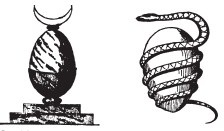
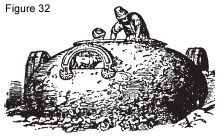

The Roman Catholic church now has their own official representation of Ishtar—the virgin mother—who stands upon the top of this sacred egg of Heliopolis, with the serpent Typhon at her feet.
The Ishtar Fertility Hare – The Easter Bunny
From The Encyclopedia Britannica, we find the following information about Easter:
Like the Easter egg, the Easter hare came to Christianity from antiquity. The hare is associated with the moon in the legends of ancient Egypt and other peoples… Through the fact that the Egyptian word for hare___um, means also open and period. The hare came to be associated with the idea of periodicity both lunar and human, and with the beginning of new life in both the young man and young woman, and so a symbol of fertility and of the renewal of life.
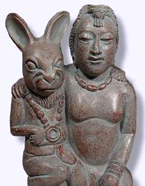
Hot Cross Buns
Another custom closely associated with Easter is the baking and eating of hot cross buns. There is, of course, no Scriptural justification for this custom, but there is great pagan justification involved. The cross is the original sign of the God Tammuz. The cross is the letter T.
The Two Babylons, by Alexander Hislop on pages 197-200, tells us the following about the sign of the cross.
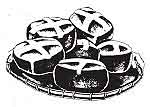
There is hardly a pagan tribe where the cross has not been found. The cross was worshiped by the pagan Celts long before the “incarnation” and death of Christ… The Druids in their groves were accustomed to select the most stately and beautiful tree as an emblem of the deity (god) they adored, and having cut the side branches, they affixed two of the largest of them to the highest part of the trunk, in such a manner that those branches extended on each side like the arms of a man, and, together with the body, presented the appearance of a huge cross, and on the bark, in several places, was also inscribed the letter “Thau”. It was worshiped in Mexico for ages before the Roman Catholic missionaries set foot there, large stone crosses being erected, probably to the “god of rain”. The cross thus widely worshiped, or regarded as a sacred emblem, was the unequivocal symbol of “Bacchus”, the Babylonian Messiah, for he was represented with a head-band covered with crosses.
Tammuz, according to Collier’s Encyclopedia, Volume 15, page 749, was the Sumero-Akkadian God of vegetation, who was known as Adoni—my Lord.
Tammuz, the Sumero-Akkadian god of vegetation. His name in Sumerian is Dumu-zi-abzu (true son of Apsu), or simply Dumu-zi, from which the Hebrew form Tammuz is derived. The cult of Tammuz, under the west-Semitic name of Adoni (my lord) and the Greek equivalent Adonis, was widespread throughout the Mediterranean world. According to still extant mythology, Tammuz died, descended to the lower world, was resurrected, and ascended again to earth and then to heaven. During his absence the earth remained sterile and the flocks were plundered. Because of his close association with the realm of nature, the fields and animals, he was called “the shepherd.”
.The International Standard Bible Encyclopedia, Volume 4, page 725, shows that the original of the name Tammuz, which is dumuzi, means invigorator of the child. Tammuz was the same Sumerian and Babylonian God of fertility, who married Easter/Ishtar at the vernal equinox.
TAMMUZ tam‘uz, tä‘mooz [Heb. tammûz; Akk. tammuz; Sum. dumuzi__“invigorator of the child (?)”]. A Sumerian and Babylonian god of fertility mentioned once in the O.T. (Eze. 8:14). The prophet in a vision during his Babylonian exile saw an abomination: women in the north gate of the Jerusalem temple wailing for Tammuz.
As this source reference has stated, Tammuz was mentioned once in Yechetzqyah.
.Yechetzqyah 8:13-14—
13 He also said to me: Turn yet again, and you will see greater abominations that they are doing.
14 Then he brought me to the door of the gate of Yahweh’s House, which was toward the north; and behold, there satwomen weeping for Tammuz.
This weeping for Tammuz was an abomination which was being practiced even by the people of Yerusalem at the time that Yechetzqyah was prophesying. This weeping was a fertility rite. One of the ceremonies of Ishtar/Easter worship, was that of weeping for the dead vegetation God, because fertility had ceased from the land. In the people’s minds, unless this God was resurrected, there would be no renewing of fertility with the great mother Goddess. So, through sympathetic magic—the weeping of his mother (Easter/Ishtar)—Tammuz was mystically resurrected. Each year these people grieved with Ishtar/Easter over the death of Tammuz; and at each vernal equinox they were rewarded as this resurrected God was reunited with his great mother Goddess, in order to ensure the success of the crops and the fertility of animals and people.
This ancient fertility worship was exactly scheduled according to the shadows of the sun. It is very easy to learn how this was done. Obtain our book, Deceptions Concerning Yahweh’s Calendar Of Events.
Hot cross buns are in reality Tammuz cakes. These little magic Tammuz cakes were made and used in the worship of Ishtar/Easter, the Queen of Heaven, for it was she who brought the God back to ensure their fertility. So, when the God returned to fertilize the mother, on the exact day of the vernal equinox, the people mystically held him in their hands and ate the God, mystically uniting with him and his mother in worship.
During the time that the Prophet Yeremyah was proclaiming Yahweh’s Laws to the people, Yahweh inspired him to rebuke His People for this pagan practice.
.Yeremyah 7:17-20—
17 Do you not see what they do in the cities of Yahdah and in the streets of Yerusalem?
18 How the children gather wood, and the fathers kindle the fire, while the women knead dough to make cakes for the Queen of Heaven, and how they pour out drink offerings to the hinder Gods (elohim), so they may act defiantly against Me?
19 Is it I Whom they act defiantly against? says Yahweh: Or is it not themselves, whom they harm to their own shame?
20 Therefore this is what Yahweh says: Behold, they have acted defiantly against Me, so justice will be poured out on this place__on man and on beast, on the trees of the field and on the fruit of the ground__and they will burn; and this fire will not be quenched.
The very things that the people were seeking to reproduce in this fertility worship—man, animals, fruits, and produce—were the very things that Yahweh would not bless because of their apostasy and God worship.
The Interpreter’s Dictionary of The Bible, Volume 3, page 975, tells us of Ishtar’s role as the Queen of Heaven:
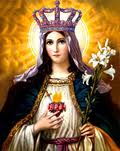
The MT (melekat) is an unusual form of melekah, the normal word for “queen” and certain MSS read melakat (“handiwork”), meaning presumably the stars; this was understood by the LXX translators in Jer. 7:18, where “the heavenly host” (th stratia tou ouranou) is read, supported by the Targ., which reads “the star(s) of heaven” (shemia kukbat). If “the queen of heaven” is to be read__which seems more probable__the reference might be to Ishtar, the goddess of love and fertility, who was identified with the Venus Star and is actually entitled “Mistress of Heaven” in the Amarna tablets. The difficulty is that the Venus Star was regarded in Palestine as a male deity (see day star), though the cult of the goddess Ishtar may have been introduced from Mesopotamia under Manasseh. It is possible that Astarte, or Ashtoreth, the Canaanite fertility-goddess, whose cult was well established in Palestine, had preserved more traces of her astral character as the female counterpart of Athtar than the evidence of the O.T. or the Ras Shamra Texts indicates. The title “Queen of Heaven” is applied in an Egyptian inscription from the Nineteenth Dynasty at Beth-shan to “Antit,” the Canaanite fertility-goddess Anat, who is termed “Queen of Heaven and Mistress of the Gods.” This is the most active goddess in the Ras Shamra Texts, but in Palestine her functions seem to have been taken over largely by Ashtoreth.
We have had the opportunity to read more than once throughout this article that the name and the festival of Easter have their origins in the worship of a pagan Goddess of spring, but Easter is now the most important Christian festival. From The Last Two Million Years by The Reader’s Digest Association, page 215, we learn how the worship of a pagan Goddess became the most important Christian festival.
Pagan rites absorbed
By a stroke of tactical genius the Church, while intolerant of pagan beliefs, was able to harness the powerful emotions generated by pagan worship. Often, churches were sited where temples had stood before, andmany heathen festivals were added to the Christian calendar. Easter, for instance, a time of sacrifice and rebirth in the Christian year, takes its name from the Norse goddess Eostre, in whose honour rites were held every spring. She in turn was simply a northern version of the Phoenician earth-mother Astarte, goddess of fertility. Easter eggs continue an age-old tradition in which the egg is a symbol of birth; and cakes which were eaten to mark the festivals of Astarte and Eostre were the direct ancestors of our hot-cross buns.
Why were the pagan rites absorbed, rather than being completely abolished? The answer to this question is that many people had been drawn to the religion called Christianity, but so strong in their minds was their adoration for the mother Goddess that they would not forsake her worship. Due to the fact that Christianity could readily transform its beliefs, compromising church leaders saw their opportunity. They found similarities in Christian customs with those of the mother Goddess and brought people by the droves into their fold.
Who did these compromising church leaders find to worship, instead of the great mother Ishtar/Easter? They found Miryam (Mary), the mother of Yahshua Messiah. Through Mary worship, the pagans could continue their customary prayers and devotion to the mediating Goddess—just change her name to Mary. This would give the pagan worship of the mother the appearance of respectability, the same respectability that it still holds today. Slowly but methodically, the religion of pagan Rome, which was a synthesis of everything that was abominable to Yahweh from the beginning, became established with its new name: Christianity.
During the first centuries of this religion, no emphasis was placed upon Mary whatsoever. But, thanks to Constantine, the savior of Christianity, in the early part of the Fourth Century of this Common Era, the worship of Mary as a Goddess was encouraged. Since Rome had long been a center for the worship of the mother Goddess of paganism, we need not be surprised that Rome was one of the first places where Mary worship, and many other renamed, but very familiar customs, became firmly rooted.
From Grolier’s Encyclopedia, Grolier Corporation, N.Y., 1966, Volume 17, we find the following information.
Easter: A Day of Joy
Though not all Protestants observe Lent and Holy Week, all Christians celebrate Easter Day, commemorating the Resurrection. Easter Day invariably falls on a Sunday, the first Sunday after the full moon following the spring equinox, usually late in March.
The name of this holiday and the time it is celebrated have led people to believe that an earlier holiday existed on this day before the Christian observance. For many ancient nations joyously celebrated the end of winter and the “resurrection of the sun” at this season of the year; and some devoted this festival to Eostre, Germanicgoddess of spring.
The Church Fathers turned this heathen holiday into the Christian celebration of the Resurrection. And Christians the world over observe this day with great rejoicing. Some greet each other with:”Christ is risen! Christ is risen!” And all think of Jesus, who conquered death so that those who follow him may gain everlasting life.
On Easter people go to church services and delight in the sight of the great masses of Easter lilies that decorate the altars. For the Chinese the peony is the king of flowers and symbol of spring. But to the people in church on Easter Day, the fragrant lily with its trumpet shaped blossoms is the symbol of purity and the welcome harbinger of spring.
The churchgoers enjoy the flowers and the music and the sermon of the day. And from time to time they look about them to observe the gay clothes that people wear, since it has long been the custom for people to put on their newest clothes on Easter Day.
The Eastern Orthodox Easter Parade
In countries where the Eastern Orthodox Church dominates, a quite different parade is put on during Easter. The worshipers gather early on Saturday night in an elaborate ritual. And at midnight, led by their priests in richly embroidered vestments, carrying images and lighted candles in their hands, they go out into the night in search of Jesus.
It is almost dawn when the people return home to eat the Easter bread with white cheese and honey and therichly colored hard boiled eggs.
Many encyclopedias will make the statement that Easter is the worship of a pagan Goddess and at the same time will state this celebration is one of the most important Christian celebrations today. In each of these reference works a statement is made, in one form or another, that Easter is the day on which the Christian church commemorates our Savior’s resurrection.
The Sunday Resurrection Lie
Christendom teaches that the Messiah rose from His grave on Sunday morning and because of this, they say, they are worshiping on the day of His resurrection. There is, however, no Scriptural proof for this Good Friday/Easter Sunday tradition. As we have seen, the foundation for this tradition is in pagan antiquity, although this tradition is taught as Scripture to deceived Christianity. Was Yahshua, our True Savior, resur-rected on Easter Sunday morning? The answer is, NO!
There is a reason this world is confused as to when our Messiah was placed in His grave. The reason being that this whole world has rejected Yahweh and His Laws. Yahweh’s Laws include Yahweh’s Feast Days, Yahweh’s weekly Seventh Day Sabbath, plus the seven Sabbath Days (Holy Convocations) which are shown in Leviticus Chapter 23.
.Leviticus 23:2—
Speak to the children of Israyl, and say to them; Concerning the Feasts of Yahweh, which you shall proclaim to beHoly Convocations; these are My Feasts.
The world has rejected not only Yahweh’s weekly Seventh Day Sabbath, but also all of Yahweh’s Feast Days (Holy Convocations) by replacing them with their own feast days which are condemned in the Holy Scriptures. (Isayah 1:13-14)
The Feasts of Yahweh are not feasts of the Jews, as many would say. Yahweh’s Feasts are not done away with either, as many would like you to think. Yahweh tells us His Feasts are Statutes forever. This world, therefore, is not led by Yahweh’s Spirit Holy, because they have rejected Yahweh, Who inspired the Prophet Hosheyah to say; …Because you have forgotten the Laws of Yahweh, I will also forget your children.
For more facts concerning Yahweh’s Sabbath Days, please write for information about how you may obtain our books,The Seventh Book of Yisrayl, Part I and II. Also request our booklet, Which Day Is The Sabbath Of The New Testament? Our booklet, What Yahweh’s Feasts Mean To You, will explain the significance of Yahweh’s Feasts for His House—The House of Yahweh.
Don’t Be Deceived!
In order for you to see through this great deception, it is vital that you understand the difference between Yahweh’s Feast Day Sabbaths and the weekly Sabbaths—the weekly Sabbaths always fall on the Seventh Day, Saturday, whereas the Feast Day Sabbaths can fall on any day of the week.
Most people today are deceived into believing that the Messiah was resurrected on Easter Sunday morning. They believe they are honoring His resurrection by celebrating an Easter sunrise service. This belief is based on the following Scripture from The King James Version which says:
.Matthew 28:1 KJV—
In the end of the sabbath, as it began to dawn toward the first day of the week, came Mary Magdalene and the other Mary to see the sepulchre.
False preachers will tell you this dawning toward the first of the week is at the time of day called sunrise. This is a false conclusion. This dawning toward the first day of the week was actually at a time of day called sunset.
To know what time of day this Scripture is referring to, we must first know the time sequence in a day. Yahweh our Heavenly Father, the Creator of the day, tells us the time sequence of a day.
.Genesis 1:5—
And Yahweh called the light day, and the darkness He called night. And (notice) the evening and then the morning were the First Day.
Yahweh created a day to be an evening (darkness) first, and then the morning (light). Genesis 1:4-13 gives the details of the creation of the first three days in a week; each day was one night, then one day—which is one day, Yahweh’s Way. The first three days of creation were a time sequence of seventy-two hours, spanning one night, one day; one night, one day; one night, one day. This same principle applies to the time span in which Yahshua was in the grave.
The words coming from Yahshua’s own mouth about His resurrection, were that He would be in the grave three days and three nights.
.Mattithyah 12:40—
For as Yahnah was three days and three nights in the belly of the great fish, so will the Son of Man be three days and three nights in the heart of the earth.
.Yahnah 1:17—
Now Yahweh had prepared a great fish to swallow up Yahnah. And Yahnah was in the belly of the fish three days and three nights.
Even the critics admit that this means a period of seventy-two hours. They admit there were three twelve hour days, and three twelve hour nights in which Yahnah was in the belly of the fish. And just as distinctly, Yahshua Messiah said that He would be in the grave for the same length of time. Not only this, but Yahshua Himself gives us the length of time in a day.
.Yahchanan 11:8-9—
8 His Disciples said to Him; Teacher, the Yahdaim just recently tried to stone You, and You go there again?
9 Yahshua answered: Are there not twelve hours in a day? If any man walks in the day, he does not stumble, because he sees the light of this world.
The teaching of the majority of Sunday keeping Christianity is that the Messiah was put in the grave on Good Friday at sunset, and was resurrected at sunrise on Easter Sunday morning. But our Messiah said that the only sign He would give that He was the True Messiah, was the sign of the Prophet Yahnah—the sign that He would be in the grave three days and three nights. Can you get three days and three nights from Christianity’s time sequence?
Friday night__one night
Saturday day__one day
Saturday night__one night
Resurrected Sunday at dawn__no day
There are two nights and one day in this time sequence. It should not be too difficult for anyone to understand that this was a period of about thirty-six hours—not seventy-two hours. Even a child can figure that there are not three days and three nights from Friday sunset to Sunday sunrise; yet, Satan has caused the majority of people in this world to accept this lie.
If Yahshua had been placed in the grave on Good Friday evening at sunset, then His resurrection should not have taken place until Monday evening at sunset.
Was our Messiah confused, or is this whole world deceived as the Holy Scriptures say in Revelation 12:9? Satan hasdeceived this whole world. Could this lie of a Sunday sunrise resurrection be one of the ways by which Satan has so subtly deceived this world?
Yahshua knew how long He would be in the grave. There was no guessing or speculation. It was absolutely necessary that Yahshua Messiah fulfill this Prophecy; otherwise, He would not prove to be the True Messiah. The True Messiah sent by Yahweh must have remained in the grave three days and three nights.
Yahshua did remain in the grave three days and three nights, proving that He was the True Messiah sent by Yahweh. Read Mattithyah 28:1 again for affirmation that the two Miryams came at the end of the Sabbath. Just after sunset, while it was still twilight, the two Miryams went to the sepulcher, and found it empty. The malak told them Yahshua had already risen and departed.
Other vital facts you must have in your mind are the facts about the sacrifice of our Messiah.
FACT #1: Our Savior was to be killed (sacrificed) at the time of the Passover.
.Mattithyah 26:2—
You know that after two days the Passover is celebrated as a Feast, but the Son of Man is betrayed before; prior to this Feast, to be sacrificed.
FACT #2: Our Messiah died as our sacrifice. He paid the death penalty for us that we may live (Romans 6:23). As our sacrifice, our Messiah is enabling us to keep Yahweh’s Passover according to His Ordinance.
FACT #3: The Messiah is our Passover Lamb.
.I Kepha 1:18-19—
18 Knowing that you were not redeemed with corruptible things, such as silver or gold, from your idolatrous way of lifehanded down to you by tradition from your forefathers;
19 But with the precious blood of Messiah, as of a Lamb without blemish and without spot.
.Yahchanan 1:29—
The next day Yahchanan saw Yahshua coming toward him, and said; Behold! The Lamb of Yahweh Who takes away the sin of the world!
.I Corinthians 5:7—
Therefore, purge out the old leaven, that you may be a new batch, since you are unleavened. For truly Yahshua our Passover was sacrificed for us.
FACT #4: Our Savior was sacrificed for us on the exact same day, at the exact same time the Passover lambs were being slaughtered on the temple mount. If this were not so, He could not be our Passover sacrifice.
This is a provable fact. Letting Scripture interpret Scripture we can understand the ordinance of the Passover lamb and the exact day it was to be kept up to.
.Exodus 12:6—
And you must keep it until the fourteenth day of the same Moon: then the whole multitude of the congregation of Israyl shall kill it between the two evenings.
This lamb had to be alive on the fourteenth day, and then it was killed between the two evenings.
The Pentateuch and Haftorahs, edited by J.H. Hertz, page 254, explains the meaning of between the two evenings.
6. at dusk. Better, towards even (M. Friedlander); lit. `between’ the-two evenings’. According to the Talmud, the`first evening’ is the time in the afternoon when the heat of the sun begins to decrease, about 3 o’clock; and the `second evening’ commences with sunset. Josephus relates that the Passover sacrifice `was offered from the ninth to the eleventh hour’, i.e. between 3 and 5 p.m.
.Leviticus 23:5—
On the fourteenth of the First Moon, between the two evenings, Yahweh’s Passover Sacrifice is to be killed.
.The Pentateuch and Haftorahs, by Hertz, page 520, gives a clearer meaning of the Passover in this Scripture.
at dusk is the LORD’S Passover. Better, towards even is a Passover unto the Lord (Friedlander) i.e. a paschal offering in honor of the Lord.
The Passover lambs were slaughtered on the temple mount on the fourteenth day in the afternoon. The man of the household had the responsibility of killing this lamb for his family. The woman of the household then had the responsibility of roasting, not boiling, this lamb until it would be thoroughly done. This roasting process would take at least three to four, or more hours.
Which Day Was The Messiah Put In The Grave? Which Day Did He Rise?
Our Messiah fulfilled the Passover Lamb requirement. Yahshua did not abrogate Yahweh’s Laws in any way. Yahshua was offered on the fourteenth day of the First Moon between the two evenings.
Immediately after that sunset would begin the fifteenth day. Remember, Yahweh created days to begin and end at sunset. Sundown on the fourteenth would be the beginning of the first Sabbath of the Feast of Unleavened Bread, on the fifteenth day.
.Leviticus 23:6-7—
6 And on the fifteenth day of the same moon is the Feast of Unleavened Bread to Yahweh; seven days you must eat unleavened bread.
7 On the first day you shall have a Holy Convocation; you shall do no regular work on it.
The world does not know the facts about the Feast Day Sabbaths—one of which is that these Feast Day Sabbaths can fall on any day of the week. With this fact firmly in mind we can then understand what is being said in:
.Yahchanan Mark 16:1—
And when the Passover Sabbath was past, Miriam Magdalene, and Miriam the mother of Yaaqob, and Salome, bought sweet spices, that they might go and anoint Him.
This Sabbath was not the weekly Sabbath! This particular Sabbath was the first Holy Day Sabbath of the Feast of Unleavened Bread.
.Luke 23:56—
Then they returned. Then they prepared spices and ointments. Then they rested the Sabbath Day according to the Law.
In these two Scriptures, we see that there are two Sabbaths spoken of. One Sabbath had already passed when they bought the spices. Then they prepared the spices they had bought after the Sabbath had already passed. Then they rested on the weekly Saturday Sabbath according to the Law of Yahweh.
By understanding these previous Scriptures we know our Savior was not put into the grave on Friday before the weekly Sabbath. We know Yahshua was placed in His grave on Wednesday just before sunset—before the Sabbath of the Feast of Unleavened Bread.
The diagram shows the two Sabbaths that came in that one week. Now we know and understand it was before the Sabbath of the Feast of Unleavened Bread that Yahseph of Arimathea demanded the Body of Yahshua and not before the weekly Saturday Sabbath.
.Yahchanan Mark 15:42-43—
42 By now, the first evening had come, and because it was the Preparation, that is, the day before the Passover High Holy Day Sabbath,
43 Yahseph of Arimathea, an honorable member of the Sanhedrin, who also waited for the Kingdom of Yahweh, came, and went in boldly to Pilate, and asked for the body of Yahshua.
In Yahchanan Mark 15:46 it is stated that Yahshua’s body was wrapped in linen and laid in a sepulcher. A stone was then rolled in front of the door. This burial took place on a Wednesday afternoon, just before sunset, as Scriptures do prove.
Prove this for yourself. Count forward: Wednesday NIGHT, Thursday DAY, Thursday NIGHT, Friday DAY, Friday NIGHT,Sabbath DAY. There are three NIGHTS and three DAYS in this time sequence.
Our Messiah was not resurrected Sunday morning at sunrise. Yahshua rose Saturday Sabbath evening, which makes it exactly three days and three nights that He was in the grave, thereby fulfilling the only sign He gave that He was the True Messiah.
For an even greater indepth study of this most important truth concerning the resurrection of the True Messiah, please request our booklets, Was The Resurrection On Sunday? and Yahweh’s Passover & Yahshua’s Memorial. Also write for information about how to obtain our books, Devil Worship…The Shocking Facts!, The Sabbath…Every Question Answered! and Deceptions Concerning Yahweh’s Calendar Of Events.
The Easter Tradition Forced Upon The Believers
The early believers knew the difference between Baal-Ashtoreth worship and the worship of Yahweh. They knew the difference, and none of the early believers, directly under the care of the Apostles, celebrated Easter.
After the death of our Savior, severe persecution arose at Yerusalem (Acts 8:1), and the believers were scattered abroad. They were forced into slavery, and even put to death in some of the most horrible ways man could imagine. However, this was only the first, ten great persecutions that came upon the established House of Yahweh. The only people on the face of the earth who worshiped Father Yahweh, was The House of Yahweh established by Yahshua during the time of the Apostles. This first era of the seven eras of The House of Yahweh is called Smyrna. This era and the four following it suffered these religious persecutions. Our book, The Lost Faith of The Apostles and Prophets; History and Prophecy, explains in detail the seven eras of The House of Yahweh, and the facts concerning the ten persecutions.
Baal and Ashtoreth worshipers had pre-eminence. From approximately the year 70 C.E. to the year 312 C.E., Baal and Ashtoreth worshipers openly practiced their religions under the benevolent eyes of man’s ruling governments.
When Constantine became the emperor of Rome, after the tenth, last and greatest persecution under Diocletian, Baal and Ashtoreth worshipers then disguised the many pagan customs making them to appear Scriptural.
By the time Constantine came to power, The House of Yahweh as an established organization had died out, just as Prophecy said it would. There was no true organization, led by Yahweh’s Spirit Holy, to say to the deceived world—Easter is a pagan celebration. Thus, the pagan celebrations became the Christian celebrations of today.
The House of Yahweh has been re-established in these Last Days according to the Prophecies in Micahyah 4:1 andIsayah 2:2. Praise Yahweh! Request our booklet, The House of Yahweh Established. Now, in these Last Days The House of Yahweh is again telling this deceived world that this worldly holiday called Easter is a pagan custom.
Yahweh’s Warning!
Throughout the Holy Scriptures we find warnings from our Creator Yahweh and His Son, Yahshua Messiah, to beware of spiritual deception. As far back in time as the Scriptural books of the kings, this female Goddess was being worshiped. The Holy Scriptures plainly show that the adoption of pagan practices and the worship of Easter is condemned.
.I Kings 11:33—
I will do this Because they have forsaken Me, and worshiped Ashtoreth the Goddess of the Phoenicians, (Sidonians), Chemosh the God (El) of the Moabites, and Milcom (Molech) the God (El) of the people of Ammon, and have not walked in My Ways, to do that which is right in My Eyes, and to keep My Statutes and My Judgments, as David his father did.
.Deuteronomy 12:29-32—
29 When Yahweh your Father cuts off the nations from in front of you, and you displace them and live in their land,
30 Be careful not to be ensnared into following them by asking about their Gods (elohim), saying: How did these nations serve their Gods (elohim)? I also will do the same.
31 You must not worship Yahweh your Father in their way, for every abomination to Yahweh, which He hates, they have done to their Gods (elohim). They even burn their sons and daughters in the fire as sacrifices to their Gods (elohim).
32 Whatsoever I command you, be careful to observe and do it, you shall not add to it, nor take away from it.
.Deuteronomy 8:19—
If you, by any means, ever forget Yahweh your Father, by following hinder Gods (Elohim) to serve and worship them, I testify and witness against you this day that you will surely perish.
.Revelation 18:3-4—
3 For all nations have drunk of the wine of the wrath of her fornication, and the kings of the earth have committed fornication with her, and the merchants of the earth have grown rich through the abundance of her delicacies.
4 And I heard another voice from heaven, saying: Come out of her, My People, so that you do not partake in her sins, and so that you do not receive of her plagues.
Source reference materials, which are available in any library throughout America, are replete with the fact that the worship of Easter/Ishtar is the worship of a pagan Goddess. Man-kind’s own reference books say the worship of Easter, a pagan Goddess, is the most important Christian practice today. Can our Creator be pleased with this?
Do Not Practice It!
Shortly, on April 24, 2011 Easter Sunday morning will be upon us. Almost the entire Christian world will participate in a sunrise service that they believe to be in celebration of the resurrection of our Messiah. Factually, this is a pagan custom celebrated long before our Savior was even born. Yahweh condemns this pagan practice through the pages of your own bible.
These same Christians reject the wonderful Feasts of Yahweh which are ordained by Yahweh and will be kept forever in the Kingdom of Yahweh. Read of Yahweh’s Feasts in Exodus Chapter 12, Leviticus Chapter 23, Yechetzqyah 45:21, Isayah 66:23 and Zecharyah 14:16-21.

The only ones who will be given Eternal Life in Yahweh’s Kingdom are the ones who obey every Word that proceeds from Yahweh’s Mouth.
.Deuteronomy 6:25—
And it will be our Righteousness, if we observe to do all these Laws before Yahweh our Father, as He has commanded us.
.Mattithyah 4:4—
But He answered, and said; It is written: Man does not live by bread alone, but by every Word that proceeds out of the Mouth of Yahweh.
.Deuteronomy 8:2-3—
2 You must remember that Yahweh your Father led you all the way these forty years in the wilderness, in order to humble you, test and prove you, and know what was in your heart; to see whether you would keep His Laws, orwhether you would not.
3 So He humbled you, and allowed you to hunger, and fed you with manna, which you did not know of nor did your fathers know of it; so He might make you to know that man does not live by bread only, but by every Word that proceeds out of the Mouth of Yahweh, does man live.
.Revelation 22:14-15—
14 Blessed are those who keep His Laws, that they may have right to the Tree of Life, and may enter in through the Gates into the City.
15 For outside are dogs, and sorcerers, and whoremongers, and murderers, and worshipers of Gods (elohim) and everyone who professes to love, yet practices breaking the Laws.

Only those who resist Satan’s influence and overcome the pagan worship practiced today, and then turn to Yahweh in complete obedience will be a part of Yahweh’s soon coming Kingdom.
It would be much better to obey Yahweh voluntarily now, thereby qualifying to reap the joyous reward of Eternal Life, rather than to voluntarily disobey Yahweh, thereby qualifying yourself to be one of those who will be cast into the lake of fire to be burned up and gotten out of the way. It is time to come out of pagan worship and start obeying Yahweh. Only Yahweh is able to give Eternal Life.
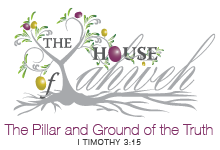
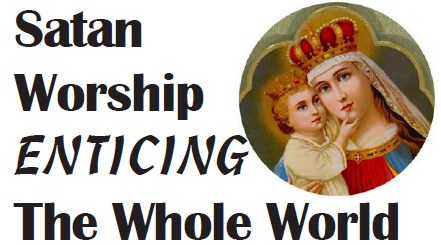
 You can read in the Inspired Scriptures that Satan has deceived the whole world, but it seems hard to believe such a thing until one actually takes a close look at the things Scripture calls Satan worship, because they are disguised to look Righteous. Plus, the preachers, referred to in Scripture as false prophets, teach that activities of Satan worship are desirable and holy.
You can read in the Inspired Scriptures that Satan has deceived the whole world, but it seems hard to believe such a thing until one actually takes a close look at the things Scripture calls Satan worship, because they are disguised to look Righteous. Plus, the preachers, referred to in Scripture as false prophets, teach that activities of Satan worship are desirable and holy.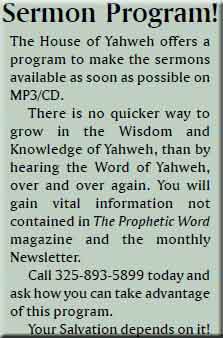 Everything about Easter looks okay until you actually study the origin of this worship and see that it’s based on nothing but lies and deception, and that it’s condemned in the very bible the deceivers hold in their hands on Sunday morning. They lie and bring forth not what is in your bible but Satan worship that your bible condemns.
Everything about Easter looks okay until you actually study the origin of this worship and see that it’s based on nothing but lies and deception, and that it’s condemned in the very bible the deceivers hold in their hands on Sunday morning. They lie and bring forth not what is in your bible but Satan worship that your bible condemns.

